#martha Nussbaum does it right
Text
“I need a break from academic philosophy!!!”
Picks up martha nussbaum’s The Fragility of Goodness.
1 note
·
View note
Note
Hi there! I've really enjoyed your blog-- there's a lot of good information on it. In fact, I just wrote a novel set in ancient Thebes, set in 335 BCE, right before Alexander's attack. However, I'm a little scared to write the sequel, because Alex is going to show up in it as a major character. He is SO famous, and there's so many books about him, that I hardly know where to begin.
So, do you have any specific books you recommend, like any good starter bios or anything else that would be good for this specific setting? (Specifically against the destruction of Thebes and right before the invasion of Persia.)
Thank you so much!
Some Useful Bibliography on Alexander (and Thebes)
Thank you! And sorry for the delay. The queries in my inbox tend to be feast or famine. LOL
In terms of information on Alexander, I would start with the brand new Cambridge Companion to Alexander the Great, edited by Daniel Ogden. It has many of the leading scholars. On Alexander and the Greeks in particular, see my dear friend Borja Antela’s chapter. This is now what I’d consider the best intro resource on Alexander for the interested non-specialist, especially as it’s reasonably priced. The bibliography will help a lot. For Macedonia itself, Carol Thomas has Alexander and His World (which I’ve used teaching) and Carol King has Ancient Macedonia. Both are good, one-book introductions.
If you’ve not already, you’ll want to consult Mark Munn’s chapter “Thebes and Central Greece” in The Greek World in the Fourth Century, Larry Tritle, ed. Paul Cartledge also has a book Thebes: The Forgotten City of Ancient Greece, but he’s a Spartan specialist. Lately, publishers have had him write on other subjects—not always to good effect, as per his book on Alexander, imo. But I’ve not read this one so can’t comment. I think Thebes is closer to his usual bailiwick.
James Romm did a book The Sacred Band., although like Cartledge Romm is all over the place. Same cautions apply. And I’ll also offer the counter-proposal that the band was not pairs of lovers, by David Leitao, "The Legend of the Sacred Band," in The Sleep of Reason by Martha Nussbaum and Juha Sihvola, eds. His view is not a homophobic diss; it’s a source problem. Plutarch is our sole source for the lovers bit, and he’s notoriously unreliable on some facts, especially when he has an ulterior message.
The more I study Plutarch, the less I trust him. LOL
Last, another friend and colleague, Jenn Finn has written a bang-up chapter on the destructions of both Thebes and Persepolis, for the upcoming collection I edited, so I got a preview. “Urbicide, Memory Sanctions, and the Perso-Macedonian Dynasty.” I’m not sure when the collection will be out, but certainly not before late 2024, and more likely 2025. She might be willing to share the draft, however, if you need it immediately. She’s at Loyola U. in Chicago. As always, Jenn does fantastic work.
#asks#alexander the great#alexander the great bibliography#ancient Thebes#Greek Thebes#The Sacred Band#books on Alexander the Great#ancient macedonia#ancient greece#Classics#tagamemnon
15 notes
·
View notes
Text
finally ordered a copy of martha nussbaum’s opus on animal rights - justice for animals: our collective responsibility (2023) which basically applies kantian/korsgaardian ethics to the animal kingdom. basically asks “what do we owe to animals and what does that tell us about what we owe each other” her intro talks about how inspired she was by her daughter rachel’s work on the legal rights of animals, esp whales. nussbaum was inspired to write this after rachels death in a routine surgery and thus extend her legacy of applying v human notions like flourishing, eudomonia and meaning into the animal kingdom. pretty sure this book is going to make me cry
17 notes
·
View notes
Text
What Do We Owe Lab Animals?
https://sciencespies.com/news/what-do-we-owe-lab-animals/
What Do We Owe Lab Animals?

The standard ethical guidelines encourage minimizing the use of, and harm to, animals used in research. Some experts propose an additional courtesy: repayment.
When Lauren Strohacker received her second Covid-19 vaccine dose in the spring of 2021, she rejoiced. It meant she could see her friends again, go to concerts and live with far less fear that an infection might leave her physically or financially devastated.
But it became a bittersweet memory. Not long after Ms. Strohacker, an artist based in Knox County, Tenn., returned home from the vaccination site, she read an article about monkeys used in testing Covid vaccines.
“I thought, I’m afraid of a stupid needle,” she said. “And these animals have to deal with this all the time.” She reflected on how her newfound freedom, and quite possibly her health, came at the expense of animals suffering or dying to develop the vaccines.
Merely being grateful for those animals seemed insufficient; Ms. Strohacker wanted to give something tangible in return. A little online research returned the National Anti-Vivisection Society’s sanctuary fund, which supports the care of retired lab animals. She made a small donation. “To give thanks was the very least I could do,” Ms. Strohacker said.
Her gesture embodies a voice that is not often heard in debates about the use of animals in biomedical research. These tend to be polarized between opponents of the research, who claim that it is unethical and the benefits are overstated, and proponents who argue that the benefits are enormous and justify the harms to animals.
The advancement of animal-free methods for developing drugs and testing product safety does raise the possibility that, at least in some cases, the use of animals can be avoided. But it will take years for that to happen, and few researchers think the use of animals will cease altogether. So long as animals are used, then, the question remains: What do people owe them?
“The typical consideration is that if I plan the research well, have an important idea and respect the animals by housing them as carefully as I can and so on, then I’ve done my job in terms of the relationship,” said John Gluck, an emeritus professor of psychology at the University of New Mexico whose growing discomfort with his use of monkeys led him to become a bioethicist. “I think that is just poverty-stricken.”
The Rights of Animals
Invertebrates: As intelligent cephalopods like octopuses and squids become more important in science, some people are seeking to give them the same protections as lab mice and monkeys.
Volunteers Only: A farm sanctuary in New York is investigating the inner lives of cows, pigs and chickens, but only if the animals choose to participate in the studies.
A Ban on Pet Sales: Stores in New York State will soon be prohibited from selling dogs, cats and rabbits under a law meant to stem the sale of animals raised in inhumane conditions.
A Case for Equal Rights: In her latest book, the philosopher Martha C. Nussbaum argues for increased legal standing for animals. David Marchese asked her about it.
Scientists often point to the so-called Three Rs, a set of principles first articulated in 1959 by William Russell, a sociologist, and Rex Burch, a microbiologist, to guide experimental research on animals. Researchers are encouraged to replace animals when alternatives are available, reduce the number of animals used and refine their use so as to minimize the infliction of pain and suffering.
These are unquestionably noble aims, ethicists note, but may seem insufficient when compared with the benefits derived from animals. Covid vaccines, for example, which were tested on mice and monkeys, and developed so quickly thanks to decades of animal-based work on mRNA vaccine technology, saved an estimated 20 million lives in their first year of use and earned tens of billions of dollars in revenues.
The breeding center for longtail macaques at the National Primate Research Center.Mladen Antonov/Agence France-Presse — Getty Images
In light of that dynamic — which applies not only to Covid vaccines, but to many other human lifesaving, fortune-generating therapeutics — some wonder if a fourth R might be warranted: repayment.
Inklings of the idea of repayment can already be found in the research community, most visibly in laboratories that make arrangements for animals — primarily monkeys and other nonhuman primates — to be retired to sanctuaries. In the case of dogs and companion species, including rats, they are sometimes adopted as pets.
“It’s kind of karma,” said Laura Conour, the executive director of Laboratory Animal Resources at Princeton University, which has a retirement arrangement with the Peaceable Primate Sanctuary. “I feel like it balances it out a little bit.” The school has also adopted out guinea pigs, anole lizards and sugar gliders as pets to private citizens, and tries to help with their veterinary care.
Adoption is not an option for animals destined to be killed, however, which raises the question of how the debt can be repaid. Lesley Sharp, a medical anthropologist at Barnard College and author of “Animal Ethos: The Morality of Human-Animal Encounters in Experimental Lab Science,” noted that research labs sometimes create memorials for animals: commemorative plaques, bulletin boards with pictures and poems and informal gatherings in remembrance.
“There is this burden the animal has to carry for humans in the context of science,” Dr. Sharp said. “They require, I think, respect, and to be recognized and honored and mourned.”
She acknowledged that honoring sacrificed animals was not quite the same as giving something back to them. To imagine what that might entail, Dr. Sharp pointed to the practice of donating one’s organs after death. Transplant recipients often want to give something in return, “but the donor is dead,” Dr. Sharp said. “Then you need somebody who is a sort of proxy for them, and that proxy is the close surviving kin.”
If someone receives a cornea or a heart from a pig — or funding to study those procedures — then they might pay for the care of another pig at a farmed animal sanctuary, Dr. Sharp proposed: “You’re going to have animals who stand in for the whole.”
A variation of that principle can be see in children’s participation in possibly risky research, said Rebecca Walker, a bioethicist at the University of North Carolina. An ill child enrolled in a clinical trial for a still-unapproved drug may receive no personal benefit, but this is considered ethically acceptable because the research will benefit a larger community of children living with that condition.
“You’re contributing to the group, even if you’re not contributing to the individual,” Dr. Walker said. “That can be really relevant to the animal case.” For example, research on captive axolotls, a critically-endangered species of salamander, has yielded insights into breast cancer, spina bifida and tissue regeneration; in return, people might support efforts to help wild axolotls now struggling to survive in polluted canals in Mexico City.
A researcher prepares an injection at the animal facility of the Center for Biological Research Margarita Salas in Madrid. The facility houses mice, rabbits and other animals required for various lines of research.Marcos del Mazo/LightRocket, via Getty Images
For Lisa Genzel, a neuroscientist at Radboud University in the Netherlands, and Judith Homberg, her collaborator at the institution’s medical school, compensating research animals is best accomplished by giving those animals a far better life than the regulations require. “We try to give back to the individual animal,” Dr. Genzel said.
That means contemplating their lives and what matters to them, she said. Dr. Genzel and Dr. Homberg said they no longer use food restriction to motivate their rats to solve mazes. They also make sure the rats can socialize not only with one another but with humans, who play with them daily.
They would like to house their rats in larger, more naturalistic enclosures, or at least cages large enough to stand up in, but “it’s not an easy thing,” Dr. Genzel said. “First we have to get the financing. We don’t have the money.” The cost of replacing the cages in a single facility can quickly run to tens of thousands of euros — and that’s without considering the price of new cage-cleaning machines.
Giving something back to research animals would entail a cost. Some experts offered that a portion of drug revenues or research grants could be earmarked for this purpose.
“I’m surprised it hasn’t been done already,” said Prem Premsrirut, chief executive of Mirimus, a company that develops animal models for testing new therapeutics. “I think that for anything we do in science, we have to give to those who sacrifice, regardless of whether it’s human beings or animals.”
For many critics of animal research, this would still not go far enough. “What we really owe the animals is to legitimately replace their use,” said Aysha Akhtar, a neurologist and former medical officer with the U.S. Food and Drug Administration who co-founded the Center for Contemporary Sciences, which supports the development of animal-free, human-relevant medical research methods.
Dr. Akhtar has called for increased funding for such methods. Revenue and grant earmarks might be devoted to this aim as well. “If I could make some part of my lab associated with the development of alternatives — to me, that’s how I could really give back,” Dr. Gluck said.
As for Ms. Strohacker, she has received her Covid vaccine boosters and is thinking of making another donation, this time in gratitude for the animals involved in testing her birth control drugs.
“We’ve been conditioned not to think about the animals who are sacrificed for our health,” Ms. Strohacker said. “I don’t think the world is so pure that we’ll ever do no harm, but we could maybe be more thankful materially for the harm that we do.”
#News
0 notes
Text
Heartbreak and how we try again
Recommendation: Icarus & Apollo by Ripto
Heartbreak is a unique sort of pain. It can vary in intensity depending on many factors (what is lost, how long the relationship with this other had lasted, what sort of love has been lost, etc.), but the pain is always recognizable as heartbreak. It is not only a feeling of loss, but also of failure on two accounts.
The first is the thought of one’s own failure. Questions like, “What did I do wrong?” “Why this, why now?” and most importantly, “What could I have done differently” swirl around in one’s mind on a seemingly endless loop. I say that the last question is the most important because it is the question that will influence the future. One will (hopefully) not give up all faith in love as a whole after a single heartbreak.

The second is the question of the failure of the other to fulfill the ideal characteristics of a partner (romantic or otherwise, partner referring to the other piece of the loving relationship). The failure of the other is not simply boiled down to something “they broke my heart” or “they did ‘X’ thing wrong.” Rather, this second failure is rooted in the characteristics of the other; it finds itself in their values and characteristics. It can seem like oversimplifying to strip one down to their traits and other qualities, but in a broader scope beyond this one “other” we can look at what all of our past loves and heartbreaks, what could also be called temporary successes and permanent failures (although perhaps that is too harsh of a comparison) have in common.
In High Fidelity, we watch as Rob details her “Top 5 heartbreaks,” explaining each in excruciating detail and constantly making fourth-wall breaking comments about each of her ex-partners to the camera. Throughout the series, Rob searches for these Top 5 heartbreaks, looking for each of them in order to discover why she is always left heartbroken and alone. Here, Rob consciously confronts the first of the two failures while almost subconsciously questioning the second. She is on a journey to find out her own wrongdoings and what she could have done differently, but she also finds herself exploring the qualities of her ex-lovers from this subjective yet exterior perspective. Enough time has passed since most of these heartbreaks where Rob can examine them from a position further than when they had just occurred. In one case, when Rob finds out that she is actually the one who ended things with her fourth ex, Justin, she feels much better about herself. Here, there is no first failure to question. For Rob, something was wrong with Justin, she had no shortcomings in this relationship.

How does one like Rob move forward from a heartbreak, and why is confronting past failed relationships (although not usually as directly as Rob does) important for moving forward? For Martha Nussbaum in her writing “Love and the Individual: Romantic Rightness and Platonic Aspiration,” there are certain positive reasons and realistic objections to deciphering what one looks for in a partner, and why some of these qualities may have been misconstrued or imagined, leading one on a road to heartbreak.
By drawing up a list of certain properties that one finds important and/or hopes to see in a partner, one can hold this list up to current and former relationships to understand how their partners have aligned or been out of place with this list of admirable qualities. People are often split on looking for a partner that is similar to them or nearly a total opposite (i.e. opposites attract). Not only that, but sometimes people find themselves falling for another after they see this person commit a certain act of kindness, bravery, or intelligence, among other admirable traits.
Nussbaum’s writing includes arguments regarding both of these ideas. First, there are some situations where qualities opposite those that one possesses may be admirable because they may be the exact qualities that one is lacking. I believe that this is true. There are people I have loved because of their ability to draw out a trait that I would never use to define myself. This is not to say that these people helped me discover something about myself (although they probably did), but rather that their qualities and values lodged themselves in my own sense of self and how love allowed me to share their perspective. Second, Nussbaum’s work points out that we do not value certain qualities that one displays unless we believe that these qualities are a regular part of their way of being. That is to say that if a person is seen being kind, they are not just feeling as though they should be kind in that one moment, but rather that they value kindness on a consistent personal level.
There does not need to be some checklist that one holds up against anyone that they find themselves in love with. I think this can be harmful. We love who we love and choose them based on certain qualities, but most or all of those qualities do not need to always be found in all who we fall in love with (although ideally the values somewhere on this list can be used to define a decent human being). Nonetheless, heartbreak can force us to use this list. We take what we believe we want in a partner and compare that with those past relationships, hoping to spot with clarity where everything went wrong.
Reality is never that simple, and love is even more complex. It is important to recognize the qualities of the person you love, it is less important to decide whether or not someone will be an ideal partner based on a predetermined list. Love is constantly changing. The reasons why we love are never stable or precise. It is an impossible task to accept that heartbreak and a lost love are not always due to some concrete reason or some after-the-fact value or characteristic of a partner.
Where does new love come from, and how do we let it into our lives? At times it can seem as though we are searching for a replacement for something we have lost. We find someone that aligns with the characteristics we deem valuable and admirable and convince ourselves that we are in love with them. Is love deceptive? Or are we the ones committing the deception, tricking ourselves into believing, “this is love”? I think this forces a distinction when it comes to moving on from a heartbreak. Moving forward in the hopes that one will find a near perfect copy of what was lost will probably end in failure. Clearly something was wrong in that previous relationship (with oneself or with the other), what will be different this time? On the other hand, moving forward in the search for a more general love can be a much more fruitful journey. We understand what qualities we admire; we are searching for a continuous feeling and a joint experience rather than an individual.
Love is not deceptive. Lust, some overwhelming feeling of being drawn to another, a passionate fascination… These can all deceive us into thinking we are in love or cause us to let our guards down, leaving the door open for perhaps unnecessary pain. But love is never misleading. It is instead embodied by those who share the traits and values that we deem most important and most admirable. Love allows us to look at the entire interior and exterior of another, at their sense of self and their perspective, and know that although it may not be permanent and that there is always the possibility of unwanted change, we can love and be loved by this other person.
0 notes
Quote
Intimate relationships are perilous because of the exposure and lack of control they involve. Being seriously wronged is a constant possibility, and anger, therefore, a constant and profoundly human temptation. If vulnerability is a necessary consequence of giving love its proper value, then grief is often right and valuable. It does not follow, however, that anger is so.
Martha Nussbaum, Anger and Forgiveness
#philosophy#quotes#Martha Nussbaum#Anger and Forgiveness#relationships#vulnerability#control#trust#anger#love#grief#emotions#feelings
446 notes
·
View notes
Text
Beyond Compassion and Humanity; Justice for Non-human Animals by Martha Nussbaum
-
This is a great essay vegans can draw on for a virtue ethics answer to the question of why do we hold the principle that it's almost always wrong to breed sentient life into captivity?
So for myself and this strain of virtue ethicists it would be because you know you could leave room for other animals to enjoy happy flourishing, being able to express all their capabilities in wild habitat.
Therefore not wanting to parasitically take away life with meaning for low-order pleasure in our hierarchy of needs which we can find elsewhere.
The distinction between this philosophy and consequentialism would simply be if you wished to act this way because fundimentally it’s about who you want to be and who you want to let animal be:
It goes beyond the contractarian view in its starting point, a basic wonder at living beings, and a wish for their flourishing and for a world in which creatures of many types flourish. It goes beyond the intuitive starting point of utilitarianism because it takes an interest not just in pleasure and pain [and interests], but in complex forms of life. It wants to see each thing flourish as the sort of thing it is. . .[and] that the dignity of living organisms not be violated.
Counter-intuitively the author does still cling to a hedonistic view of the right to take life, but hopefully not for much longer:
If animals were really killed in a painless fashion, after a healthy and free-ranging life, what then? Killings of extremely young animals would still be problematic, but it seems unclear that the balance of considerations supports a complete ban on killings for food.
-
BEYOND “COMPASSION AND HUMANITY”
Justice for Non-human Animals
MARTHA C. NUSSBAUM
Certainly it is wrong to be cruel to animals… The capacity for feelings of pleasure and pain and for the forms of life of which animals are capable clearly impose duties of compassion and humanity in their case. I shall not attempt to explain these considered beliefs. They are outside the scope of the theory of justice, and it does not seem possible to extend the contract doctrine so as to include them in a natural way.
—JOHN RAWLS, A Theory of Justice
In conclusion, we hold that circus animals…are housed in cramped cages, subjected to fear, hunger, pain, not to mention the undignified way of life they have to live, with no respite and the impugned notification has been issued in conformity with the…values of human life, [and] philosophy of the Constitution… Though not homo-sapiens [sic], they are also beings entitled to dignified existence and humane treatment sans cruelty and torture… Therefore, it is not only our fundamental duty to show compassion to our animal friends, but also to recognise and protect their rights…If humans are entitled to fundamental rights, why not animals?
—NAIR V. UNION OF INDIA, Kerala High Court, June 2000
-
“BEINGS ENTITLED TO DIGNIFIED EXISTENCE”
In 55 B.C. the Roman leader Pompey staged a combat between humans and elephants. Surrounded in the arena, the animals perceived that they had no hope of escape. According to Pliny, they then ―entreated the crowd, trying to win their compassion with indescribable gestures, bewailing their plight with a sort of lamentation.‖ The audience, moved to pity and anger by their plight, rose to curse Pompey, feeling, writes Cicero, that the elephants had a relation of commonality (societas) with the human race. [1]
We humans share a world and its scarce resources with other intelligent creatures. These creatures are capable of dignified existence, as the Kerala High Court says. It is difficult to know precisely what we mean by that phrase, but it is rather clear what it does not mean: the conditions of the circus animals in the case, squeezed into cramped, filthy cages, starved, terrorized, and beaten, given only the minimal care that would make them presentable in the ring the following day. The fact that humans act in ways that deny animals a dignified existence appears to be an issue of justice, and an urgent one, although we shall have to say more to those who would deny this claim. There is no obvious reason why notions of basic justice, entitlement, and law cannot be extended across the species barrier, as the Indian court boldly does.
Before we can perform this extension with any hope of success, however, we need to get clear about what theoretical approach is likely to prove most adequate. I shall argue that the capabilities approach as I have developed it—an approach to issues of basic justice and entitlement and to the making of fundamental political principles [2] —provides better theoretical guidance in this area than that supplied by contractarian and utilitarian approaches to the question of animal entitlements, because it is capable of recognizing a wide range of types of animal dignity, and of corresponding needs for flourishing.
-
KANTIAN CONTRACTARIANISM: INDIRECT DUTIES, DUTIES OF COMPASSION
Kant’s own view about animals is very unpromising. He argues that all duties to animals are merely indirect duties to humanity, in that (as he believes) cruel or kind treatment of animals strengthens tendencies to behave in similar fashion to humans. Thus he rests the case for decent treatment of animals on a fragile empirical claim about psychology. He cannot conceive that beings who (in his view) lack self-consciousness and the capacity for moral reciprocity could possibly be objects of moral duty. More generally, he cannot see that such a being can have dignity, an intrinsic worth.
One may, however, be a contractarian—and indeed, in some sense a Kantian— without espousing these narrow views. John Rawls insists that we have direct moral duties to animals, which he calls ―duties of compassion and humanity. [3] But for Rawls these are not issues of justice, and he is explicit that the contract doctrine cannot be extended to deal with these issues, because animals lack those properties of human beings ―in virtue of which they are to be treated in accordance with the principles of justice‖ (TJ 504). Only moral persons, defined with reference to the ―two moral powers,‖ are subjects of justice.
To some extent, Rawls is led to this conclusion by his Kantian conception of the person, which places great emphasis on rationality and the capacity for moral choice. But it is likely that the very structure of his contractarianism would require such a conclusion, even in the absence of that heavy commitment to rationality. The whole idea of a bargain or contract involving both humans and non-human animals is fantastic, suggesting no clear scenario that would assist our thinking. Although Rawls’s Original Position, like the state of nature in earlier contractarian theories, [4] is not supposed to be an actual historical situation, it is supposed to be a coherent fiction that can help us think well. This means that it has to have realism, at least, concerning the powers and needs of the parties and their basic circumstances. There is no comparable fiction about our decision to make a deal with other animals that would be similarly coherent and helpful. Although we share a world of scarce resources with animals, and although there is in a sense a state of rivalry among species that is comparable to the rivalry in the state of nature, the asymmetry of power between humans and non-human animals is too great to imagine the bargain as a real bargain. Nor can we imagine that the bargain would actually be for mutual advantage, for if we want to protect ourselves from the incursions of wild animals, we can just kill them, as we do. Thus, the Rawlsian condition that no one party to the contract is strong enough to dominate or kill all the others is not met. Thus Rawls’s omission of animals from the theory of justice is deeply woven into the very idea of grounding principles of justice on a bargain struck for mutual advantage (on fair terms) out of a situation of rough equality.
To put it another way, all contractualist views conflate two questions, which might have been kept distinct: Who frames the principles? And for whom are the principles framed? That is how rationality ends up being a criterion of membership in the moral community: because the procedure imagines that people are choosing principles for themselves. But one might imagine things differently, including in the group for whom principles of justice are included many creatures who do not and could not participate in the framing.
We have not yet shown, however, that Rawls’s conclusion is wrong. I have said that the cruel and oppressive treatment of animals raises issues of justice, but I have not really defended that claim against the Rawlsian alternative. What exactly does it mean to say that these are issues of justice, rather than issues of ―compassion and humanity? The emotion of compassion involves the thought that another creature is suffering significantly, and is not (or not mostly) to blame for that suffering. [5] It does not involve the thought that someone is to blame for that suffering. One may have compassion for the victim of a crime, but one may also have compassion for someone who is dying from disease (in a situation where that vulnerability to disease is nobody’s fault). ―Humanity I take to be a similar idea. So compassion omits the essential element of blame for wrongdoing. That is the first problem. But suppose we add that element, saying that duties of compassion involve the thought that it is wrong to cause animals suffering. That is, a duty of compassion would not be just a duty to have compassion, but a duty, as a result of one’s compassion, to refrain from acts that cause the suffering that occasions the compassion. I believe that Rawls would make this addition, although he certainly does not tell us what he takes duties of compassion to be. What is at stake, further, in the decision to say that the mistreatment of animals is not just morally wrong, but morally wrong in a special way, raising questions of justice?
This is a hard question to answer, since justice is a much-disputed notion, and there are many types of justice, political, ethical, and so forth. But it seems that what we most typically mean when we call a bad act unjust is that the creature injured by that act has an entitlement not to be treated in that way, and an entitlement of a particularly urgent or basic type (since we do not believe that all instances of unkindness, thoughtlessness, and so forth are instances of injustice, even if we do believe that people have a right to be treated kindly, and so on). The sphere of justice is the sphere of basic entitlements. When I say that the mistreatment of animals is unjust, I mean to say not only that it is wrong of us to treat them in that way, but also that they have a right, a moral entitlement, not to be treated in that way. It is unfair to them. I believe that thinking of animals as active beings who have a good and who are entitled to pursue it naturally leads us to see important damages done to them as unjust. What is lacking in Rawls’s account, as in Kant’s (though more subtly) is the sense of the animal itself as an agent and a subject, a creature in interaction with whom we live. As we shall see, the capabilities approach does treat animals as agents seeking a flourishing existence; this basic conception, I believe, is one of its greatest strengths.
-
UTILITARIANISM AND ANIMAL FLOURISHING
Utilitarianism has contributed more than any other ethical theory to the recognition of animal entitlements. Both Bentham and Mill in their time and Peter Singer in our own have courageously taken the lead in freeing ethical thought from the shackles of a narrow species-centered conception of worth and entitlement. No doubt this achievement was connected with the founders’ general radicalism and their skepticism about conventional morality, their willingness to follow the ethical argument wherever it leads. These remain very great virtues in the utilitarian position. Nor does utilitarianism make the mistake of running together the question “who receives justice?” With the question “who frames the principles of justice?” Justice is sought for all sentient beings, many of whom cannot participate in the framing of principles.
Thus it is in a spirit of alliance that those concerned with animal entitlements might address a few criticisms to the utilitarian view. There are some difficulties with the utilitarian view, in both of its forms. As Bernard Williams and Amartya Sen usefully analyze the utilitarian position, it has three independent elements: consequentialism (the right choice is the one that produces the best overall consequences), sum-ranking (the utilities of different people are combined by adding them together to produce a single total), and hedonism, or some other substantive theory of the good (such as preference satisfaction). [6] Consequentialism by itself causes the fewest difficulties, since one may always adjust the account of well-being, or the good, in consequentialism so as to admit many important things that utilitarians typically do not make salient: plural and heterogeneous goods, the protection of rights, even personal commitments or agent-centred goods. More or less any moral theory can be consequentialized, that is, put in a form where the matters valued by that theory appear in the account of consequences to be produced. [7] Although I do have some doubts about a comprehensive consequentialism as the best basis for political principles in a pluralistic liberal society, I shall not comment on them at present, but shall turn to the more evidently problematic aspects of the utilitarian view. [8]
Let us next consider the utilitarian commitment to aggregation, or what is called ―sum-ranking. Views that measure principles of justice by the outcome they produce need not simply add all the relevant goods together. They may weight them in other ways. For example, one may insist that each and every person has an indefeasible entitlement to come up above a threshold on certain key goods. In addition, a view may, like Rawls’s view, focus particularly on the situation of the least well off, refusing to permit inequalities that do not raise that person’s position. These ways of considering well-being insist on treating people as ends: They refuse to allow some people’s extremely high well-being to be purchased, so to speak, through other people’s disadvantage. Even the welfare of society as a whole does not lead us to violate an individual, as Rawls says.
Utilitarianism notoriously refuses such insistence on the separateness and inviolability of persons. Because it is committed to the sum-ranking of all relevant pleasures and pains (or preference satisfactions and frustrations), it has no way of ruling out in advance results that are extremely harsh toward a given class or group. Slavery, the lifelong subordination of some to others, the extremely cruel treatment of some humans or of non-human animals—none of this is ruled out by the theory’s core conception of justice, which treats all satisfactions as fungible in a single system. Such results will be ruled out, if at all, by empirical considerations regarding total or average well-being. These questions are notoriously indeterminate (especially when the number of individuals who will be born is also unclear, a point I shall take up later). Even if they were not, it seems that the best reason to be against slavery, torture, and lifelong subordination is a reason of justice, not an empirical calculation of total or average well-being. Moreover, if we focus on preference satisfaction, we must confront the problem of adaptive preferences. For while some ways of treating people badly always cause pain (torture, starvation), there are ways of subordinating people that creep into their very desires, making allies out of the oppressed. Animals too can learn submissive or fear-induced preferences. Martin Seligman’s experiments, for example, show that dogs who have been conditioned into a mental state of learned helplessness have immense difficulty learning to initiate voluntary movement, if they can ever do so. [9]
There are also problems inherent in the views of the good most prevalent within utilitarianism: hedonism (Bentham) and preference satisfaction (Singer). Pleasure is a notoriously elusive notion. Is it a single feeling, varying only in intensity and duration, or are the different pleasures as qualitatively distinct as the activities with which they are associated? Mill, following Aristotle, believed the latter, but if we once grant that point, we are looking at a view that is very different from standard utilitarianism, which is firmly wedded to the homogeneity of good. [10]
Such a commitment looks like an especially grave error when we consider basic political principles. For each basic entitlement is its own thing, and is not bought off, so to speak, by even a very large amount of another entitlement. Suppose we say to a citizen: We will take away your free speech on Tuesdays between 3 and 4P.M., but in return, we will give you, every single day, a double amount of basic welfare and health care support. This is just the wrong picture of basic political entitlements. What is being said when we make a certain entitlement basic is that it is important always and for everyone, as a matter of basic justice. The only way to make that point sufficiently clearly is to preserve the qualitative separateness of each distinct element within our list of basic entitlements.
Once we ask the hedonist to admit plural goods, not commensurable on a single quantitative scale, it is natural to ask, further, whether pleasure and pain are the only things we ought to be looking at. Even if one thinks of pleasure as closely linked to activity, and not simply as a passive sensation, making it the sole end leaves out much of the value we attach to activities of various types. There seem to be valuable things in an animal’s life other than pleasure, such as free movement and physical achievement, and also altruistic sacrifice for kin and group. The grief of an animal for a dead child or parent, or the suffering of a human friend, also seem to be valuable, a sign of attachments that are intrinsically good. There are also bad pleasures, including some of the pleasures of the circus audience—and it is unclear whether such pleasures should even count positively in the social calculus. Some pleasures of animals in harming other animals may also be bad in this way.
Does preference utilitarianism do better? We have already identified some problems, including the problem of misinformed or malicious preferences and that of adaptive (submissive) preferences. Singer’s preference utilitarianism, moreover, defining preference in terms of conscious awareness, has no room for deprivations that never register in the animal’s consciousness.
But of course animals raised under bad conditions can’t imagine the better way of life they have never known, and so the fact that they are not living a more flourishing life will not figure in their awareness. They may still feel pain, and this the utilitarian can consider. What the view cannot consider is all the deprivation of valuable life activity that they do not feel.
Finally, all utilitarian views are highly vulnerable on the question of numbers. The meat industry brings countless animals into the world who would never have existed but for that. For Singer, these births of new animals are not by themselves a bad thing: Indeed, we can expect new births to add to the total of social utility, from which we would then subtract the pain such animals suffer. It is unclear where this calculation would come out. Apart from this question of indeterminacy, it seems unclear that we should even say that these births of new animals are a good thing, if the animals are brought into the world only as tools of human rapacity.
So utilitarianism has great merits, but also great problems.
-
TYPES OF DIGNITY, TYPES OF FLOURISHING: EXTENDING THE CAPABILITIES APPROACH
The capabilities approach in its current form starts from the notion of human dignity and a life worthy of it. But I shall now argue that it can be extended to provide a more adequate basis for animal entitlements than the other two theories under consideration. The basic moral intuition behind the approach concerns the dignity of a form of life that possesses both deep needs and abilities; its basic goal is to address the need for a rich plurality of life activities. With Aristotle and Marx, the approach has insisted that there is waste and tragedy when a living creature has the innate, or ―basic,‖ capability for some functions that are evaluated as important and good, but never gets the opportunity to perform those functions. Failures to educate women, failures to provide adequate health care, failures to extend the freedoms of speech and conscience to all citizens—all these are treated as causing a kind of premature death, the death of a form of flourishing that has been judged to be worthy of respect and wonder. The idea that a human being should have a chance to flourish in its own way, provided it does no harm to others, is thus very deep in the account the capabilities approach gives of the justification of basic political entitlements.
The species norm is evaluative, as I have insisted; it does not simply read off norms from the way nature actually is. The difficult questions this valuational exercise raises for the case of non-human animals will be discussed in the following section. But once we have judged that a central human power is one of the good ones, one of the ones whose flourishing defines the good of the creature, we have a strong moral reason for promoting its flourishing and removing obstacles to it.
-
Dignity and Wonder: The Intuitive Starting Point
The same attitude to natural powers that guides the approach in the case of human beings guides it in the case of all forms of life. For there is a more general attitude behind the respect we have for human powers, and it is very different from the type of respect that animates Kantian ethics. For Kant, only humanity and rationality are worthy of respect and wonder; the rest of nature is just a set of tools. The capabilities approach judges instead, with the biologist Aristotle (who criticized his students’ disdain for the study of animals), that there is something wonderful and wonder-inspiring in all the complex forms of animal life.
Aristotle’s scientific spirit is not the whole of what the capabilities approach embodies, for we need, in addition, an ethical concern that the functions of life not be impeded, that the dignity of living organisms not be violated. And yet, if we feel wonder looking at a complex organism, that wonder at least suggests the idea that it is good for that being to flourish as the kind of thing it is. And this idea is next door to the ethical judgment that it is wrong when the flourishing of a creature is blocked by the harmful agency of another. That more complex idea lies at the heart of the capabilities approach.
So I believe that the capabilities approach is well placed, intuitively, to go beyond both contractarian and utilitarian views. It goes beyond the contractarian view in its starting point, a basic wonder at living beings, and a wish for their flourishing and for a world in which creatures of many types flourish. It goes beyond the intuitive starting point of utilitarianism because it takes an interest not just in pleasure and pain, but in complex forms of life. It wants to see each thing flourish as the sort of thing it is.
-
By Whom and for Whom? The Purposes of Social Cooperation
For a contractarian, as we have seen, the question ―Who makes the laws and principles? is treated as having, necessarily, the same answer as the question ―For whom are the laws and principles made? That conflation is dictated by the theory’s account of the purposes of social cooperation. But there is obviously no reason at all why these two questions should be put together in this way. The capabilities approach, as so far developed for the human case, looks at the world and asks how to arrange that justice be done in it. Justice is among the intrinsic ends that it pursues. Its parties are imagined looking at all the brutality and misery, the goodness and kindness of the world and trying to think how to make a world in which a core group of very important entitlements, inherent in the notion of human dignity, will be protected. Because they look at the whole of the human world, not just people roughly equal to themselves, they are able to be concerned directly and non-derivatively, as we saw, with the good of the mentally disabled. This feature makes it easy to extend the approach to include human-animal relations.
Let us now begin the extension. The purpose of social cooperation, by analogy and extension, ought to be to live decently together in a world in which many species try to flourish. (Cooperation itself will now assume multiple and complex forms.) The general aim of the capabilities approach in charting political principles to shape the human-animal relationship would be, following the intuitive ideas of the theory, that no animal should be cut off from the chance at a flourishing life and that all animals should enjoy certain positive opportunities to flourish. With due respect for a world that contains many forms of life, we attend with ethical concern to each characteristic type of flourishing and strive that it not be cut off or fruitless.
Such an approach seems superior to contractarianism because it contains direct obligations of justice to animals; it does not make these derivative from or posterior to the duties we have to fellow humans, and it is able to recognize that animals are subjects who have entitlements to flourishing and who thus are subjects of justice, not just objects of compassion. It is superior to utilitarianism because it respects each individual creature, refusing to aggregate the goods of different lives and types of lives. No creature is being used as a means to the ends of others, or of society as a whole. The capabilities approach also refuses to aggregate across the diverse constituents of each life and type of life. Thus, unlike utilitarianism, it can keep in focus the fact that each species has a different form of life and different ends; moreover, within a given species, each life has multiple and heterogeneous ends.
-
How Comprehensive?
In the human case, the capabilities approach does not operate with a fully comprehensive conception of the good, because of the respect it has for the diverse ways in which people choose to live their lives in a pluralistic society. It aims at securing some core entitlements that are held to be implicit in the idea of a life with dignity, but it aims at capability, not functioning, and it focuses on a small list. In the case of human-animal relations, the need for restraint is even more acute, since animals will not in fact be participating directly in the framing of political principles, and thus they cannot revise them over time should they prove inadequate.
And yet there is a countervailing consideration: Human beings affect animals’ opportunities for flourishing pervasively, and it is hard to think of a species that one could simply leave alone to flourish in its own way. The human species dominates the other species in a way that no human individual or nation has ever dominated other humans. Respect for other species’ opportunities for flourishing suggests, then, that human law must include robust, positive political commitments to the protection of animals, even though, had human beings not so pervasively interfered with animals’ ways of life, the most respectful course might have been simply to leave them alone, living the lives that they make for themselves.
-
The Species and the Individual
What should the focus of these commitments be? It seems that here, as in the human case, the focus should be the individual creature. The capabilities approach attaches no importance to increased numbers as such; its focus is on the well-being of existing creatures and the harm that is done to them when their powers are blighted.
As for the continuation of species, this would have little moral weight as a consideration of justice (though it might have aesthetic significance or some other sort of ethical significance), if species were just becoming extinct because of factors having nothing to do with human action that affects individual creatures. But species are becoming extinct because human beings are killing their members and damaging their natural environments. Thus, damage to species occurs through damage to individuals, and this individual damage should be the focus of ethical concern within the capabilities approach.
-
Do Levels of Complexity Matter?
Almost all ethical views of animal entitlements hold that there are morally relevant distinctions among forms of life. Killing a mosquito is not the same sort of thing as killing a chimpanzee. But the question is: What sort of difference is relevant for basic justice? Singer, following Bentham, puts the issue in terms of sentience. Animals of many kinds can suffer bodily pain, and it is always bad to cause pain to a sentient being. If there are non-sentient or barely sentient animals—and it appears that crustaceans, mollusks, sponges, and the other creatures Aristotle called ―stationary animals‖ are such creatures—there is either no harm or only a trivial harm done in killing them. Among the sentient creatures, moreover, there are some who can suffer additional harms through their cognitive capacity: A few animals can foresee and mind their own deaths, and others will have conscious, sentient interests in continuing to live that are frustrated by death. The painless killing of an animal that does not foresee its own death or take a conscious interest in the continuation of its life is, for Singer and Bentham, not bad, for all badness, for them, consists in the frustration of interests, understood as forms of conscious awareness. [11] Singer is not, then, saying that some animals are inherently more worthy of esteem than others. He is simply saying that, if we agree with him that all harms reside in sentience, the creature’s form of life limits the conditions under which it can actually suffer harm.
Similarly, James Rachels, whose view does not focus on sentience alone, holds that the level of complexity of a creature affects what can be a harm for it. [12] What is relevant to the harm of pain is sentience; what is relevant to the harm of a specific type of pain is a specific type of sentience (e.g., the ability to imagine one’s own death). What is relevant to the harm of diminished freedom is a capacity for freedom or autonomy. It would make no sense to complain that a worm is being deprived of autonomy, or a rabbit of the right to vote.
What should the capabilities approach say about this issue? It seems to me that it should not follow Aristotle in saying that there is a natural ranking of forms of life, some being intrinsically more worthy of support and wonder than others. That consideration might have evaluative significance of some other kind, but it seems dubious that it should affect questions of basic justice.
Rachels’s view offers good guidance here. Because the capabilities approach finds ethical significance in the flourishing of basic (innate) capabilities—those that are evaluated as both good and central (see the section on evaluating animal capabilities)—it will also find harm in the thwarting or blighting of those capabilities. More complex forms of life have more and more complex capabilities to be blighted, so they can suffer more and different types of harm. Level of life is relevant not because it gives different species differential worth per se, but because the type and degree of harm a creature can suffer varies with its form of life.
At the same time, I believe that the capabilities approach should admit the wisdom in utilitarianism. Sentience is not the only thing that matters for basic justice, but it seems plausible to consider sentience a threshold condition for membership in the community of beings who have entitlements based on justice. Thus, killing a sponge does not seem to be a matter of basic justice.
-
Does the Species Matter?
For the utilitarians, and for Rachels, the species to which a creature belongs has no moral relevance. All that is morally relevant are the capacities of the individual creature: Rachels calls this view ―moral individualism.‖ Utilitarian writers are fond of comparing apes to young children and to mentally disabled humans. The capabilities approach, by contrast, with its talk of characteristic functioning and forms of life, seems to attach some significance to species membership as such. What type of significance is this?
We should admit that there is much to be learned from reflection on the continuum of life. Capacities do crisscross and overlap; a chimpanzee may have more capacity for empathy and perspectival thinking than a very young child or an older autistic child. And capacities that humans sometimes arrogantly claim for themselves alone are found very widely in nature. But it seems wrong to conclude from such facts that species membership is morally and politically irrelevant. A mentally disabled child is actually very different from a chimpanzee, though in certain respects some of her capacities may be comparable. Such a child’s life is tragic in a way that the life of a chimpanzee is not tragic: She is cut off from forms of flourishing that, but for the disability, she might have had, disabilities that it is the job of science to prevent or cure, wherever that is possible. There is something blighted and disharmonious in her life, whereas the life of a chimpanzee may be perfectly flourishing. Her social and political functioning is threatened by these disabilities, in a way that the normal functioning of a chimpanzee in the community of chimpanzees is not threatened by its cognitive endowment.
All this is relevant when we consider issues of basic justice. For a child born with Down syndrome, it is crucial that the political culture in which he lives make a big effort to extend to him the fullest benefits of citizenship he can attain, through health benefits, education, and the reeducation of the public culture. That is so because he can only flourish as a human being. He has no option of flourishing as a happy chimpanzee. For a chimpanzee, on the other hand, it seems to me that expensive efforts to teach language, while interesting and revealing, are not matters of basic justice. A chimpanzee flourishes in its own way, communicating with its own community in a perfectly adequate manner that has gone on for ages.
In short, the species norm (duly evaluated) tells us what the appropriate benchmark is for judging whether a given creature has decent opportunities for flourishing.
-
EVALUATING ANIMAL CAPABILITIES: NO NATURE WORSHIP
In the human case, the capabilities view does not attempt to extract norms directly from some facts about human nature. We should know what we can about the innate capacities of human beings, and this information is valuable, in telling us what our opportunities are and what our dangers might be. But we must begin by evaluating the innate powers of human beings, asking which ones are the good ones, the ones that are central to the notion of a decently flourishing human life, a life with dignity. Thus not only evaluation but also ethical evaluation is put into the approach from the start. Many things that are found in human life are not on the capabilities list.
There is a danger in any theory that alludes to the characteristic flourishing and form of life of a species: the danger of romanticizing nature, or suggesting that things are in order as they are, if only we would stop interfering. This danger looms large when we turn from the human case, where it seems inevitable that we will need to do some moral evaluating, to the animal case, where evaluating is elusive and difficult. Inherent in at least some environmentalist writing is a picture of nature as harmonious and wise, and of humans as wasteful overreachers who would live better were we to get in tune with this fine harmony. This image of nature was already very sensibly attacked by John Stuart Mill in his great essay ―Nature,‖ which pointed out that nature, far from being morally normative, is actually violent, heedless of moral norms, prodigal, full of conflict, harsh to humans and animals both. A similar view lies at the heart of much modern ecological thinking, which now stresses the inconstancy and imbalance of nature, [13] arguing, inter alia, that many of the natural ecosystems that we admire as such actually sustain themselves to the extent that they do only on account of various forms of human intervention.
Thus, a no-evaluation view, which extracts norms directly from observation of animals’ characteristic ways of life, is probably not going to be a helpful way of promoting the good of animals. Instead, we need a careful evaluation of both ―nature‖ and possible changes. Respect for nature should not and cannot mean just leaving nature as it is, and must involve careful normative arguments about what plausible goals might be.
In the case of humans, the primary area in which the political conception inhibits or fails to foster tendencies that are pervasive in human life is the area of harm to others. Animals, of course, pervasively cause harm, both to members of their own species and, far more often, to members of other species.
In both of these cases, the capabilities theorist will have a strong inclination to say that the harm-causing capabilities in question are not among those that should be protected by political and social principles. But if we leave these capabilities off the list, how can we claim to be promoting flourishing lives? Even though the capabilities approach is not utilitarian and does not hold that all good is in sentience, it will still be difficult to maintain that a creature who feels frustration at the inhibition of its predatory capacities is living a flourishing life. A human being can be expected to learn to flourish without homicide and, let us hope, even without most killing of animals. But a lion who is given no exercise for its predatory capacity appears to suffer greatly.
Here the capabilities view may, however, distinguish two aspects of the capability in question. The capability to kill small animals, defined as such, is not valuable, and political principles can omit it (and even inhibit it in some cases, to be discussed in the following section). But the capability to exercise one’s predatory nature so as to avoid the pain of frustration may well have value, if the pain of frustration is considerable. Zoos have learned how to make this distinction. Noticing that they were giving predatory animals insufficient exercise for their predatory capacities, they had to face the question of the harm done to smaller animals by allowing these capabilities to be exercised. Should they give a tiger a tender gazelle to crunch on? The Bronx Zoo has found that it can give the tiger a large ball on a rope, whose resistance and weight symbolize the gazelle. The tiger seems satisfied. Wherever predatory animals are living under direct human support and control, these solutions seem the most ethically sound.
-
POSITIVE AND NEGATIVE, CAPABILITY AND FUNCTIONING
In the human case, there is a traditional distinction between positive and negative duties that it seems important to call into question. Traditional moralities hold that we have a strict duty not to commit aggression and fraud, but we have no correspondingly strict duty to stop hunger or disease, nor to give money to promote their cessation. [14]
The capabilities approach calls this distinction into question. All the human capabilities require affirmative support, usually including state action. This is just as true of protecting property and personal security as it is of health care, just as true of the political and civil liberties as it is of providing adequate shelter.
In the case of animals, unlike the human case, there might appear to be some room for a positive-negative distinction that makes some sense. It seems at least coherent to say that the human community has the obligation to refrain from certain egregious harms toward animals, but that it is not obliged to support the welfare of all animals, in the sense of ensuring them adequate food, shelter, and health care. The animals themselves have the rest of the task of ensuring their own flourishing.
There is much plausibility in this contention. And certainly if our political principles simply ruled out the many egregious forms of harm to animals, they would have done quite a lot. But the contention, and the distinction it suggests, cannot be accepted in full. First of all, large numbers of animals live under humans’ direct control: domestic animals, farm animals, and those members of wild species that are in zoos or other forms of captivity. Humans have direct responsibility for the nutrition and health care of these animals, as even our defective current systems of law acknowledge. [15] Animals in the wild appear to go their way unaffected by human beings. But of course that can hardly be so in many cases in today’s world. Human beings pervasively affect the habitats of animals, determining opportunities for nutrition, free movement, and other aspects of flourishing.
Thus, while we may still maintain that one primary area of human responsibility to animals is that of refraining from a whole range of bad acts (to be discussed shortly), we cannot plausibly stop there. The only questions should be how extensive our duties are, and how to balance them against appropriate respect for the autonomy of a species.
In the human case, one way in which the approach respects autonomy is to focus on capability, and not functioning, as the legitimate political goal. But paternalistic treatment (which aims at functioning rather than capability) is warranted wherever the individual’s capacity for choice and autonomy is compromised (thus, for children and the severely mentally disabled). This principle suggests that paternalism is usually appropriate when we are dealing with non-human animals. That conclusion, however, should be qualified by our previous endorsement of the idea that species autonomy, in pursuit of flourishing, is part of the good for non-human animals. How, then, should the two principles be combined, and can they be coherently combined? I believe that they can be combined, if we adopt a type of paternalism that is highly sensitive to the different forms of flourishing that different species pursue. It is no use saying that we should just let tigers flourish in their own way, given that human activity ubiquitously affects the possibilities for tigers to flourish. This being the case, the only decent alternative to complete neglect of tiger flourishing is a policy that thinks carefully about the flourishing of tigers and what habitat that requires, and then tries hard to create such habitats. In the case of domestic animals, an intelligent paternalism would encourage training, discipline, and even, where appropriate, strenuous training focused on special excellences of a breed (such as the border collie or the hunter-jumper). But the animal, like a child, will retain certain entitlements, which they hold regardless of what their human guardian thinks about it. They are not merely objects for human beings’ use and control.
-
TOWARD BASIC POLITICAL PRINCIPLES: THE CAPABILITIES LIST
It is now time to see whether we can actually use the human basis of the capabilities approach to map out some basic political principles that will guide law and public policy in dealing with animals. The list I have defended as useful in the human case is as follows:
The Central Human Capabilities
Being able to live to the end of a human life of normal length; not dying prematurely, or before one’s life is so reduced as to be not worth living.
Bodily Health. Being able to have good health, including reproductive health; to be adequately nourished; to have adequate shelter.
Bodily Integrity. Being able to move freely from place to place; to be secure against violent assault, including sexual assault and domestic violence; having opportunities for sexual satisfaction and for choice in matters of reproduction.
Senses, Imagination, and Thought. Being able to use the senses, to imagine, think, and reason—and to do these things in a ―truly human‖ way, a way informed and cultivated by an adequate education, including, but by no means limited to, literacy and basic mathematical and scientific training. Being able to use imagination and thought in connection with experiencing and producing works and events of one’s own choice, religious, literary, musical, and so forth. Being able to use one’s mind in ways protected by guarantees of freedom of expression with respect to both political and artistic speech, and freedom of religious exercise. Being able to have pleasurable experiences and to avoid non-beneficial pain.
Emotions. Being able to have attachments to things and people outside ourselves; to love those who love and care for us and to grieve at their absence; in general, to love, to grieve, to experience longing, gratitude, and justified anger. Not having one’s emotional development blighted by fear and anxiety. (Supporting this capability means supporting forms of human association that can be shown to be crucial to our development.)
Practical Reason. Being able to form a conception of the good and to engage in critical reflection about the planning of one’s life. (This entails protection for the liberty of conscience and religious observance.)
Affiliation. (A) Being able to live with and toward others, to recognize and show concern for other human beings, to engage in various forms of social interaction; to be able to imagine the situation of another. (Protecting this capability means protecting institutions that constitute and nourish such forms of affiliation, and also protecting the freedom of assembly and political speech.) (B) Having the social bases of self-respect and non-humiliation; being able to be treated as a dignified being whose worth is equal to that of others. (This entails provisions of non-discrimination on the basis of race, sex, sexual orientation, ethnicity, caste, religion, national origin.)
Other Species. Being able to live with concern for and in relation to animals, plants, and the world of nature.
Play. Being able to laugh, to play, to enjoy recreational activities.
Control over One’s Environment. (A) Political. Being able to participate effectively in political choices that govern one’s life; having the right of political participation; protections of free speech and association. (B) Material. Being able to hold property (both land and movable goods), and having property rights on an equal basis with others; having the right to seek employment on an equal basis with others; having the freedom from unwarranted search and seizure. In work, being able to work as a human being, exercising practical reason and entering into meaningful relationships of mutual recognition with other workers.
Although the entitlements of animals are species specific, the main large categories of the existing list, suitably fleshed out, turn out to be a good basis for a sketch of some basic political principles.
In the capabilities approach, all animals are entitled to continue their lives, whether or not they have such a conscious interest. All sentient animals have a secure entitlement against gratuitous killing for sport. Killing for luxury items such as fur falls in this category, and should be banned. On the other hand, intelligently respectful paternalism supports euthanasia for elderly animals in pain. In the middle are the very difficult cases, such as the question of predation to control populations, and the question of killing for food. The reason these cases are so difficult is that animals will die anyway in nature, and often more painfully. Painless predation might well be preferable to allowing the animal to be torn to bits in the wild or starved through overpopulation. As for food, the capabilities approach agrees with utilitarianism in being most troubled by the torture of living animals. If animals were really killed in a painless fashion, after a healthy and free-ranging life, what then? Killings of extremely young animals would still be problematic, but it seems unclear that the balance of considerations supports a complete ban on killings for food.
Bodily Health. One of the most central entitlements of animals is the entitlement to a healthy life. Where animals are directly under human control, it is relatively clear what policies this entails: laws banning cruel treatment and neglect; laws banning the confinement and ill treatment of animals in the meat and fur industries; laws forbidding harsh or cruel treatment for working animals, including circus animals; laws regulating zoos and aquariums, mandating adequate nutrition and space. Many of these laws already exist, although they are not well enforced. The striking asymmetry in current practice is that animals being raised for food are not protected in the way other animals are protected. This asymmetry must be eliminated.
Bodily Integrity. This goes closely with the preceding. Under the capabilities approach, animals have direct entitlements against violations of their bodily integrity by violence, abuse, and other forms of harmful treatment—whether or not the treatment in question is painful. Thus the declawing of cats would probably be banned under this rubric, on the grounds that it prevents the cat from flourishing in its own characteristic way, even though it may be done in a painfree manner and cause no subsequent pain. On the other hand, forms of training that, though involving discipline, equip the animal to manifest excellences that are part of its characteristic capabilities profile would not be eliminated.
Senses, Imagination, and Thought. For humans, this capability creates a wide range of entitlements: to appropriate education, to free speech and artistic expression, to the freedom of religion. It also includes a more general entitlement to pleasurable experiences and the avoidance of non-beneficial pain. By now it ought to be rather obvious where the latter point takes us in thinking about animals: toward laws banning harsh, cruel, and abusive treatment and ensuring animals’ access to sources of pleasure, such as free movement in an environment that stimulates and pleases the senses. The freedom-related part of this capability has no precise analogue, and yet we can come up with appropriate analogues in the case of each type of animal, by asking what choices and areas of freedom seem most important to each. Clearly this reflection would lead us to reject close confinement and to regulate the places in which animals of all kinds are kept for spaciousness, light and shade, and the variety of opportunities they offer the animals for a range of characteristic activities. Again, the capabilities approach seems superior to utilitarianism in its ability to recognize such entitlements, for few animals will have a conscious interest, as such, in variety and space.
Emotions. Animals have a wide range of emotions. All or almost all sentient animals have fear. Many animals can experience anger, resentment, gratitude, grief, envy, and joy. A small number—those who are capable of perspectival thinking—can experience compassion. [16] Like human beings, they are entitled to lives in which it is open to them to have attachments to others, to love and care for others, and not to have those attachments warped by enforced isolation or the deliberate infliction of fear. We understand well what this means where our cherished domestic animals are in question. Oddly, we do not extend the same consideration to animals we think of as ―wild. Until recently, zoos took no thought for the emotional needs of animals, and animals being used for research were often treated with gross carelessness in this regard, being left in isolation and confinement when they might easily have had decent emotional lives. [17]
Practical Reason. In each case, we need to ask to what extent the creature has a capacity to frame goals and projects and to plan its life. To the extent that this capacity is present, it ought to be supported, and this support requires many of the same policies already suggested by capability 4: plenty of room to move around, opportunities for a variety of activities.
Affiliation. In the human case, this capability has two parts: an interpersonal part (being able to live with and toward others) and a more public part, focused on self-respect and non-humiliation. It seems to me that the same two parts are pertinent for non-human animals. Animals are entitled to opportunities to form attachments (as in capability 5) and to engage in characteristic forms of bonding and interrelationship. They are also entitled to relations with humans, where humans enter the picture, that are rewarding and reciprocal, rather than tyrannical. At the same time, they are entitled to live in a world public culture that respects them and treats them as dignified beings. This entitlement does not just mean protecting them from instances of humiliation that they will feel as painful. The capabilities approach here extends more broadly than utilitarianism, holding that animals are entitled to world policies that grant them political rights and the legal status of dignified beings, whether they understand that status or not.
Other Species. If human beings are entitled to ―be able to live with concern for and in relation to animals, plants, and the world of nature,‖ so too are other animals, in relation to species not their own, including the human species, and the rest of the natural world. This capability, seen from both the human and the animal side, calls for the gradual formation of an interdependent world in which all species will enjoy cooperative and mutually supportive relations with one another. Nature is not that way and never has been. So it calls, in a very general way, for the gradual supplanting of the natural by the just.
Play. This capability is obviously central to the lives of all sentient animals. It calls for many of the same policies we have already discussed: provision of adequate space, light, and sensory stimulation in living places, and, above all, the presence of other species members.
Control over One’s Environment. In the human case, this capability has two prongs, the political and the material. The political is defined in terms of active citizenship and rights of political participation. For non-human animals, the important thing is being part of a political conception that is framed so as to respect them and that is committed to treating them justly. It is important, however, that animals have entitlements directly, so that a human guardian has standing to go to court, as with children, to vindicate those entitlements. On the material side, for non-human animals, the analogue to property rights is respect for the territorial integrity of their habitats, whether domestic or in the wild.
Are there animal capabilities not covered by this list, suitably specified? It seems to me not, although in the spirit of the capabilities approach we should insist that the list is open-ended, subject to supplementation or deletion.
In general, the capabilities approach suggests that it is appropriate for nations to include in their constitutions or other founding statements of principle a commitment to animals as subjects of political justice and a commitment that animals will be treated with dignity. The constitution might also spell out some of the very general principles suggested by this capabilities list. The rest of the work of protecting animal entitlements might be done by suitable legislation and by court cases demanding the enforcement of the law, where it is not enforced. At the same time, many of the issues covered by this approach cannot be dealt with by nations in isolation, but can only be addressed by international cooperation. So we also need international accords committing the world community to the protection of animal habitats and the eradication of cruel practices.
-
THE INELIMINABILITY OF CONFLICT
In the human case, we often face the question of conflict between one capability and another. But if the capabilities list and its thresholds are suitably designed, we ought to say that the presence of conflict between one capability and another is a sign that society has gone wrong somewhere. [18] We should focus on long-term planning that will create a world in which all the capabilities can be secured to all citizens.
Our world contains persistent and often tragic conflicts between the well-being of human beings and the well-being of animals. Some bad treatment of animals can be eliminated without serious losses in human wellbeing: Such is the case with the use of animals for fur, and the brutal and confining treatment of animals used for food. The use of animals for food in general is a much more difficult case, since nobody really knows what the impact on the world environment would be of a total switch to vegetarian sources of protein, or the extent to which such a diet could be made compatible with the health of all the world’s children. A still more difficult problem is the use of animals in research.
A lot can be done to improve the lives of research animals without stopping useful research. As Steven Wise has shown, primates used in research often live in squalid, lonely conditions while they are used as medical subjects. This of course is totally unnecessary and morally unacceptable and could be ended without ending the research. Some research that is done is unnecessary and can be terminated, for example, the testing of cosmetics on rabbits, which seems to have been bypassed without loss of quality by some cosmetic firms. But much important research with major consequences for the life and health of human beings and other animals will inflict disease, pain, and death on at least some animals, even under the best conditions.
I do not favor stopping all such research. What I do favor is (a) asking whether the research is really necessary for a major human capability; (b) focusing on the use of less-complex sentient animals where possible, on the grounds that they suffer fewer and lesser harms from such research; (c) improving the conditions of research animals, including palliative terminal care when they have contracted a terminal illness, and supportive interactions with both humans and other animals; (d) removing the psychological brutality that is inherent in so much treatment of animals for research; (e) choosing topics cautiously and seriously, so that no animal is harmed for a frivolous reason; and (f) a constant effort to develop experimental methods (for example, computer simulations) that do not have these bad consequences.
Above all, it means constant public discussion of these issues, together with an acknowledgment that such uses of animals in research are tragic, violating basic entitlements. Such public acknowledgments are far from useless. They state what is morally true, and thus acknowledge the dignity of animals and our own culpability toward them. They reaffirm dispositions to behave well toward them where no such urgent exigencies intervene. Finally, they prompt us to seek a world in which the pertinent research could in fact be done in other ways.
-
TOWARD A TRULY GLOBAL JUSTICE
It has been obvious for a long time that the pursuit of global justice requires the inclusion of many people and groups who were not previously included as fully equal subjects of justice: the poor; members of religious, ethnic, and racial minorities; and more recently women, the disabled, and inhabitants of nations distant from one’s own.
But a truly global justice requires not simply that we look across the world for other fellow species members who are entitled to a decent life. It also requires looking around the world at the other sentient beings with whose lives our own are inextricably and complexly intertwined. Traditional contractarian approaches to the theory of justice did not and, in their very form, could not confront these questions as questions of justice. Utilitarian approaches boldly did so, and they deserve high praise. But in the end, I have argued, utilitarianism is too homogenizing—both across lives and with respect to the heterogeneous constituents of each life—to provide us with an adequate theory of animal justice. The capabilities approach, which begins from an ethically attuned wonder before each form of animal life, offers a model that does justice to the complexity of animal lives and their strivings for flourishing. Such a model seems an important part of a fully global theory of justice.
-
NOTES
This essay derives from my Tanner Lectures in 2003 and is published by courtesy of the University of Utah Press and the Trustees of the Tanner Lectures on Human Values.
The incident is discussed in Pliny Nat. Hist. 8.7.20–21, Cicero Ad Fam. 7.1.3; see also Dio Cassius Hist. 39, 38, 2–4. See the discussion in Richard Sorabji, Animal Minds and Human Morals: The Origins of the Western Debate (Ithaca, N.Y.: Cornell University Press, 1993), 124–125.
For this approach, see Martha C. Nussbaum, Women and Human Development (Cambridge: Cambridge University Press, 2000), and ―Capabilities as Fundamental Entitlements: Sen and Social Justice, Feminist Economics 9 (2003): 33–59. The approach was pioneered by Amartya Sen within economics, and is used by him in some rather different ways, without a definite commitment to a normative theory of justice.
All references are to John Rawls, A Theory of Justice (Cambridge, Mass.: Harvard University Press, 1971), hereafter TJ.
Rawls himself makes the comparison at TJ 12; his analogue to the state of nature is the equality of the parties in the Original Position.
See the analysis in Martha C. Nussbaum, Upheavals of Thought: The Intelligence of Emotions (Cambridge: Cambridge University Press, 2001), ch. 6; thus far the analysis is uncontroversial, recapitulating a long tradition of analysis.
See Amartya Sen and Bernard Williams, introduction to Utilitarianism and Beyond (Cambridge: Cambridge University Press, 1982), 3–4.
See the comment by Nussbaum in Goodness and Advice, Judith Jarvis Thomson’s Tanner Lectures (Princeton, N.J.: Princeton University Press, 2000), discussing work along these lines by Amartya Sen and others.
Briefly put, my worries are those of Rawls in Political Liberalism (New York: Columbia University Press, 1996), who points out that it is illiberal for political principles to contain any comprehensive account of what is best. Instead, political principles should be committed to a partial set of ethical norms endorsed for political purposes, leaving it to citizens to fill out the rest of the ethical picture in accordance with their own comprehensive conceptions of value, religious or secular. Thus I would be happy with a partial political consequentialism, but not with comprehensive consequentialism, as a basis for political principles.
Martin Seligman, Helplessness: On Development, Depression, and Death (New York: Freeman, 1975).
Here I agree with Thomson (who is thinking mostly about Moore); see Goodness and Advice.
Peter Singer, ―Animals and the Value of Life,‖ in Matters of Life and Death: New Introductory Essays on Moral Philosophy, ed. Tom Regan (New York: Random House, 1980), 356.
James Rachels, Created from Animals: The Moral Implications of Darwinism (New York: Oxford University Press, 1990).
Daniel B. Botkin, ―Adjusting Law to Nature’s Discordant Harmonies,‖ Duke Environmental Law and Policy Forum 7 (1996): 25–37.
See the critique by Martha Nussbaum in ―Duties of Justice, Duties of Material Aid: Cicero’s Problematic Legacy,‖ Journal of Political Philosophy 7 (1999): 1–31.
The laws do not cover all animals, in particular, not animals who are going to be used for food or fur.
On all this, see Nussbaum, Upheavals of Thought, ch. 2.
See Steven Wise, Rattling the Cage: Toward Legal Rights for Animals (Cambridge, Mass.: Perseus, 2000), ch. 1.
See Martha C. Nussbaum, ―The Costs of Tragedy: Some Moral Implications of Cost-Benefit Analysis,‖ in Cost-Benefit Analysis, ed. Matthew D. Adler and Eric A. Posner (Chicago: University of Chicago Press, 2001), 169–200.
#vegan#animal rights#animal liberation#animal welfare#virtue ethics#martha nussbaum#justice#human rights#environmental protection#environmentalist#philosophy
4 notes
·
View notes
Text
Suppose we grant Butler her most interesting claims up to this point: that the social structure of gender is ubiquitous, but we can resist it by subversive and parodic acts. Two significant questions remain. What should be resisted, and on what basis? What would the acts of resistance be like, and what would we expect them to accomplish?
Butler uses several words for what she takes to be bad and therefore worthy of resistance: the "repressive," the "subordinating," the "oppressive." But she provides no empirical discussion of resistance of the sort that we find, say, in Barry Adam's fascinating sociological study The Survival of Domination (1978), which studies the subordination of blacks, Jews, women, and gays and lesbians, and their ways of wrestling with the forms of social power that have oppressed them. Nor does Butler provide any account of the concepts of resistance and oppression that would help us, were we really in doubt about what we ought to be resisting.
Butler departs in this regard from earlier social-constructionist feminists, all of whom used ideas such as non-hierarchy, equality, dignity, autonomy, and treating as an end rather than a means, to indicate a direction for actual politics. Still less is she willing to elaborate any positive normative notion. Indeed, it is clear that Butler, like Foucault, is adamantly opposed to normative notions such as human dignity, or treating humanity as an end, on the grounds that they are inherently dictatorial. In her view, we ought to wait to see what the political struggle itself throws up, rather than prescribe in advance to its participants. Universal normative notions, she says, "colonize under the sign of the same."
This idea of waiting to see what we get--in a word, this moral passivity--seems plausible in Butler because she tacitly assumes an audience of like-minded readers who agree (sort of) about what the bad things are--discrimination against gays and lesbians, the unequal and hierarchical treatment of women--and who even agree (sort of) about why they are bad (they subordinate some people to others, they deny people freedoms that they ought to have). But take that assumption away, and the absence of a normative dimension becomes a severe problem.
Try teaching Foucault at a contemporary law school, as I have, and you will quickly find that subversion takes many forms, not all of them congenial to Butler and her allies. As a perceptive libertarian student said to me, Why can't I use these ideas to resist the tax structure, or the antidiscrimination laws, or perhaps even to join the militias? Others, less fond of liberty, might engage in the subversive performances of making fun of feminist remarks in class, or ripping down the posters of the lesbian and gay law students' association. These things happen. They are parodic and subversive. Why, then, aren't they daring and good?
Well, there are good answers to those questions, but you won't find them in Foucault, or in Butler. Answering them requires discussing which liberties and opportunities human beings ought to have, and what it is for social institutions to treat human beings as ends rather than as means--in short, a normative theory of social justice and human dignity. It is one thing to say that we should be humble about our universal norms, and willing to learn from the experience of oppressed people. It is quite another thing to say that we don't need any norms at all. Foucault, unlike Butler, at least showed signs in his late work of grappling with this problem; and all his writing is animated by a fierce sense of the texture of social oppression and the harm that it does.
Come to think of it, justice, understood as a personal virtue, has exactly the structure of gender in the Butlerian analysis: it is not innate or "natural," it is produced by repeated performances (or as Aristotle said, we learn it by doing it), it shapes our inclinations and forces the repression of some of them. These ritual performances, and their associated repressions, are enforced by arrangements of social power, as children who won't share on the playground quickly discover. Moreover, the parodic subversion of justice is ubiquitous in politics, as in personal life. But there is an important difference. Generally we dislike these subversive performances, and we think that young people should be strongly discouraged from seeing norms of justice in such a cynical light. Butler cannot explain in any purely structural or procedural way why the subversion of gender norms is a social good while the subversion of justice norms is a social bad. Foucault, we should remember, cheered for the Ayatollah, and why not? That, too, was resistance, and there was indeed nothing in the text to tell us that that struggle was less worthy than a struggle for civil rights and civil liberties.
There is a void, then, at the heart of Butler's notion of politics. This void can look liberating, because the reader fills it implicitly with a normative theory of human equality or dignity. But let there be no mistake: for Butler, as for Foucault, subversion is subversion, and it can in principle go in any direction. Indeed, Butler's naively empty politics is especially dangerous for the very causes she holds dear. For every friend of Butler, eager to engage in subversive performances that proclaim the repressiveness of heterosexual gender norms, there are dozens who would like to engage in subversive performances that flout the norms of tax compliance, of non-discrimination, of decent treatment of one's fellow students. To such people we should say, you cannot simply resist as you please, for there are norms of fairness, decency, and dignity that entail that this is bad behavior. But then we have to articulate those norms--and this Butler refuses to do.
–Martha Nussbaum, “The Professor of Parody” (1999)
24 notes
·
View notes
Quote
And yet it is much too simple to say that power is all that the body is. We might have had the bodies of birds or dinosaurs or lions, but we do not; and this reality shapes our choices. Culture can shape and reshape some aspects of our bodily existence, but it does not shape all the aspects of it. "In the man burdened by hunger and thirst," as Sextus Empiricus observed long ago, "it is impossible to produce by argument the conviction that he is not so burdened." This is an important fact also for feminism, since women's nutritional needs (and their special needs when pregnant or lactating) are an important feminist topic. Even where sex difference is concerned, it is surely too simple to write it all off as culture; nor should feminists be eager to make such a sweeping gesture. Women who run or play basketball, for example, were right to welcome the demolition of myths about women's athletic performance that were the product of male-dominated assumptions; but they were also right to demand the specialized research on women's bodies that has fostered a better understanding of women's training needs and women's injuries. In short: what feminism needs, and sometimes gets, is a subtle study of the interplay of bodily difference and cultural construction. And Butler's abstract pronouncements, floating high above all matter, give us none of what we need.
The Professor of Parody by Martha Nussbaum
20 notes
·
View notes
Text
BILL MOYERS: One of my favorites is Antigone and the conflict between her loyalty to her family, “I must bury my dead brother, even though he’s been a traitor to the state,” and Creon’s loyalty to the State, to the welfare, protection of the whole society. Sadly, they all end up dead. No one, no one comes to peace with that conflict.
MARTHA NUSSBAUM: And yet, Creon, by the end of the play, has seen something that he didn’t see before. Because all through the play, he defines enemies as anyone who opposes the good of the city, even if it happens to be a member of his own family. The claim of the family just doesn’t exist for him. But then by the end of the play, the fact that his son has died and that that does mean something to him, that has come forward, and he now says that his deliberation has been very bad.
BILL MOYERS: I saw Antigone with a clarity that I had never imagined possible when I watched Lyndon Johnson pursuing the war in Vietnam, which he thought absolutely right to do for the sake of the state, refuse to stop his two sons-in-law from going. Knowing that their death there could be a personal blow, indescribable. I saw the torture of the conflicting loyalties there.
MARTHA NUSSBAUM: The sad thing is he didn’t learn enough from that, perhaps, he didn’t see quickly enough what that meant for families in America generally.
BILL MOYERS: Do you think Creon saw — did he do something about what he saw? Or was the seeing of it, was the realization, the recognition, enough?
MARTHA NUSSBAUM: Well, up to then he thinks of the State somehow as though it doesn’t consist of families. And he keeps talking about the city, but he forgets that — what does a city consist of? It consists of families who love their children. And who are torn apart by civil war, and who have relatives on the opposing side. He won’t see the state in complex enough terms. By the end of the play, I think he’s on the verge of doing that, he’s ready to do that. But it’s too late.
BILL MOYERS: You just said something that I think is very important. That what these moral conflicts reveal is the truth of personality behind the abstractions. If you think of the state without thinking of the family, you’re thinking of something abstract that enables you to do what you would never do as a ruler if you thought of the human beings behind those abstractions.
MARTHA NUSSBAUM: Yes, and I think in general the Greeks were on the right track when they though I that what we’re aiming al in political life is to produce a of them.
BILL MOYERS: Let’s take an example. You have written that these ancient Greeks were preoccupied with the notion of a livable life. Now, what do you take that phrase to mean, a livable life?
MARTHA NUSSBAUM: Well, I think it means, first of all, that they are preoccupied with the idea of a life that has many different parts. That is a life that is rich and full, that involves many different activities. Now, it also turns out that these activities are not entirely under people’s control at all times. That a lot of them, like the ability to love and care for a family, the ability to get an education, the ability to think well, even the ability to be a moral person and to choose well, all of these require support from the surrounding society.
And so they have the image often of the person as like a plant, something that is fairly sturdy, that has a definite structure, but that is always in need of support from the surrounding society. And the political leader in that image is like the gardener, who has to tend the plant. Now, I think if you see human life that way, and you think of the role of politics as providing conditions of support for all the richly diverse elements in a full human life, that does have very definite consequences for the way you’re going to think.
0 notes
Photo

“Chalk One Up” | Directed by Seith Mann, Cinematography by David Klein

The episode opens with Carrie arriving from a long night out doing… God knows what with God knows who. We love the starkness of this close-up on the exterminated motorcycle light. According to Lesli Linka Glatter, this mode of transport is based on a real life story:
“The scene where she gets out of the embassy was based on the real agent who Carrie is based on. She was based in Iraq at the time and that’s how she got out: by dressing as a man and traveling on a motorcycle. So, we used that for this. Also, you can’t leave in Kabul without an armored vehicle.”

...as the camera slowly pans up to reveal it’s Carrie underneath that (gigantor) motorcycle helmet, the question becomes clear: where the fuck was she?
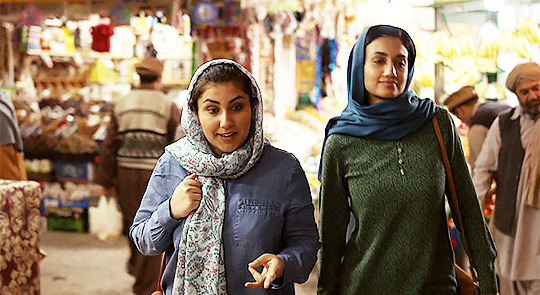
Sara loved these scenes between Samira and her friend. Homeland has depicted several cities in the Middle East over the years but has rarely given us glimpses into the world outside the walls of a hotel or CIA station, especially without our main characters. The market that Samira and her friend walk through is vibrant and filled with color, as are their outfits. It’s a stark contrast to the interiors of the CIA station. And Samira’s line that the Taliban didn’t go away but were no longer hiding proves remarkably predictive of the rest of the episode’s events.

The real highlight of the scene is the selfie, of course. We love the detail of the man on the far, far left being cut out. Samira’s friend is the master of the one-arm selfie!

This shot of the various players at the Kabul station looking outward at Carrie is striking. It’s almost a reverse fish bowl. Carrie remains on the outside but everyone’s looks are in her direction. Jenna standing at the front of the room further suggests she was never “stuck in the starting gate.” She’s in the same position of power in that room as the Chief of Station and the commanding military officer at right. From afar, the dynamics are almost similar to early season one, Carrie running an ops meeting with Saul by her side. All of which is to say… is Jenna the Carrie to Mike’s Saul?

Dog.
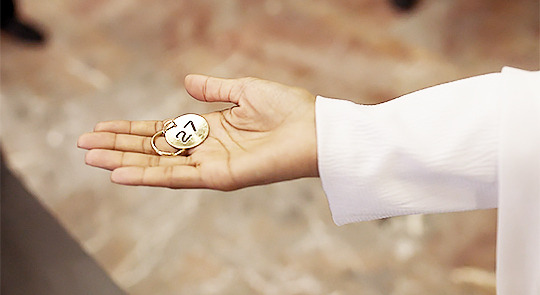
This was such a specific detail that we thought it required pointing out, but 27 is not a significant number on this show (at least that we can remember), so we’re not sure why they bothered to show this.
...unless it’s a reference to the general ominousness of the 27 Club and a hint that Carrie (who, to be fair, is far past the age of 27) is going to die.

This week the show confirmed that Tasneem is the Director of the ISI. Which means that (after President Elizabeth Keane) she’s the second most powerful woman ever depicted on this show. And boy does she dress the part!
Tasneem’s all-white ensemble is attention-grabbing and distinctive (the other women in this frame are dressed in dark clothes). It’s also visually similar--especially with her long, black hair peeking through the sheer fabric of her headscarf--to the dress worn by several other men at the reception.
Homeland has told lots of stories over the years--whether intentional or otherwise--about the challenges women face living in a patriarchal, misogynist society. Whether it’s Martha losing her career because her loser husband couldn’t stand having a wife who was more powerful and smarter than he…. Or Allison dying in the back of a car near the Russian border in an act of scorned lover revenge. Or Carrie, screaming and crying at the end of “The Vest”... but being right the whole time.
Or, as Abigail Nussbaum said more elegantly than we ever could:
“Carrie is, in many ways, a boogeyman; she is what professional women, and particularly ones in male-dominated professions, have been taught never to become - emotional, hysterical, crazy. Emotion is how women who want to be taken seriously are undermined and dismissed. Even if you’re perfectly sane, being emotional - and most especially, being angry - devalues you and your professional contribution. A woman can be called crazy simply for behaving like a normal human being rather than a robot (and of course, if she behaves robotically and unemotionally, she’s a cold bitch). But Carrie isn’t simply emotional (though she is that too, and worst of all, she allows her feelings for a man to cloud her judgment) - she actually is crazy and hysterical, in the proper clinical sense rather than the exaggerated one which attaches to any feminine display of emotion, and profoundly pathetic and unattractive in that state. And she’s completely right, the only person who figures out Brody and Abu Nazir’s plans and motivations, and the person who saves the day by being hysterical, infecting Brody’s daughter with enough of that hysteria that she calls her father and convinces him not to blow himself up.
It’s certainly possible to read this arc as purely tragic, Carrie’s self-destruction being the cost of saving the world (though this is a character arc that is applied to men as often as women, for example in Thomas Harris’s Red Dragon), but to my mind its effect is more complex. It makes a crazy, hysterical woman into a hero without in any way mitigating her craziness or hysteria, and thus defangs the argument that emotion in women is a weakness. It’s the rational, sane men around Carrie, who turn away from her unattractive mania with distaste and embarrassment, who are blind and incompetent, and it’s that same inability to look past surfaces that leads them to put their trust, wrongfully, in Brody - just as Carrie performs hysterical femininity, Brody performs stalwart masculinity. Both are misleading.”
All of which is to say, we’re really fucking pumped to see how Tasneem’s role expands for the rest of the season, and we think the array of women in Tasneem, Carrie, and Jenna and their varying degrees of power is going to be really interesting to see unfold.

Sara is obsessed with this shot. She’s obsessed with the set design of Samira’s apartment. She’s obsessed with this moody lighting. She’s basically just obsessed.
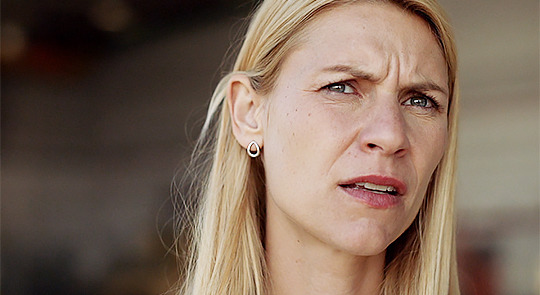

Last week we had a slow pan around Jalal to reveal Tasneem. This week we have a similar slow pan around Carrie to reveal Jenna. This definitely means that Sara’s theory that Jenna will “single white female” Carrie is right on track.
Also, Gail hereby declares Carrie’s delicate silver jewelry her “FULL circle earrings,” because everything is coming full circle this episode, including accessories.

That said, we can’t deny the power of this shot. First, we have to note what’s going on in the background (which is actually in focus). President Beau has just arrived off Air Force One and immediately stops for a photo op with the Afghan president. From the beginning, the show is clear this is an optics-based trip.
But we really love this image of Carrie and Jenna (out of focus, but in the foreground) side by side. Again, they mirror each other, but in opposite ways (“So they’re mirror opposites?” --Sara’s brain). Carrie’s light hair versus Jenna’s dark hair. Jenna’s light jacket versus Carrie’s dark one. It’s eerie.
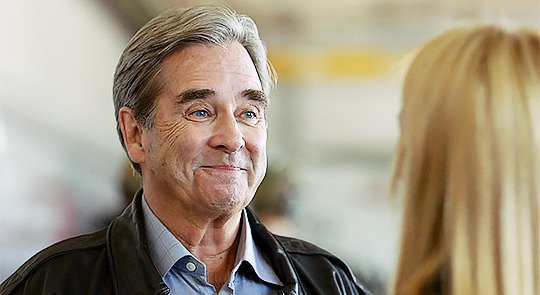

On the podcast we talked at length about the scene between Beau and Carrie. It’s genuinely moving. The staging of it is unique as well. The camera shoots them both at the same height. They stand close together. Ironically, the power dynamic seems almost equal. He’s one of the few people who’s ever acknowledged the sacrifices she’s made in service of her country.
Their twin smiles here are all the more tragic following the sequence of events that closes the episode. They all sincerely want peace. So many characters smile real, genuine smiles this week. That’s not a normal Homeland occurrence!
And they all legitimately believe in what they’re doing. They believe they’re doing the right thing. Maybe they are. But partly out of necessity, and partly out of more selfish desires (Hayes later says it’s all about getting a second term), they get caught up in the theater of it all. They make poor decisions. They take the wrong risks.
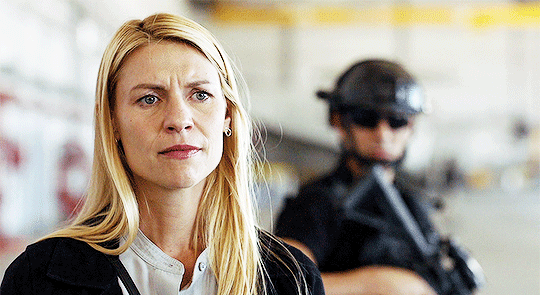
Every so often in this series we have to abandon screenshots in favor of gifs in order to truly capture ~the moment~ and this is one of those times! The way Claire plays Carrie’s reaction here is so specific, so nuanced and strange and wonderful. These “lived in” moments are something we’ll really miss when the show is over.

IJLTP.

We’ve all been there, Carrie.

This is another interesting shot choice. We’re not sure what its purpose is, other than to add interest to a fairly run-of-the-mill scene. But still, the set design! *heart eyes*

Sara’s note for this shot was “Saul is so extra.” We talked about genuine and sincere smiles above and Saul’s here does qualify… sort of. This is halfway between genuine and self-aggrandizing. AKA “where Saul lives 100% of the time.” He looks like a director about to screen his short film at Sundance. The red curtains parting slowly behind him are Too Much.
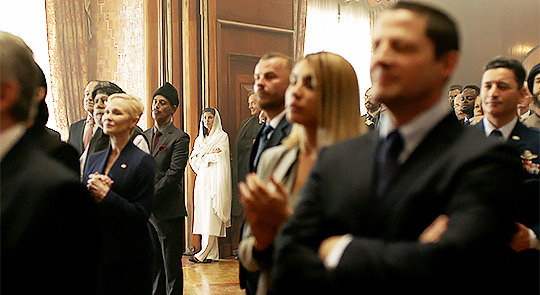
Tasneem and G’ulom are the kids in the back of the classroom who are so fucking done with this shit but can’t leave because they’ll get detention. We will continue to stan.




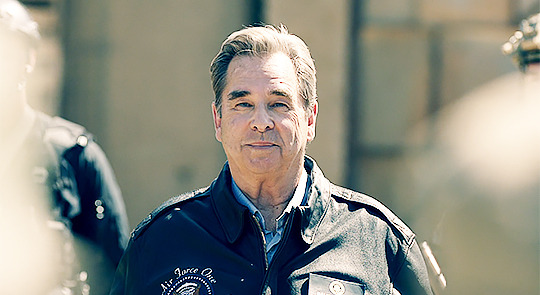
It’s a classic Homeland device to show a significant moment from a variety of perspectives, especially if those perspectives involve screens. The multitude of angles on Beau’s speech here reminded us a lot of Keane’s resignation speech in the Oval Office in “Paean to the People.” Coincidentally, that was her last hurrah as president too.
(P.S. Another Saul over-the-shoulder shot!)

Two selfies in one episode!


We loved the payoff to Max’s subplot. For once this season the weird LA filter actually looks nice! These are beautiful shots and the reflection in Max’s glasses is especially striking.

The skull and crossbones on the barracks is an ominious detail. As is the rock labeled “Boredom Rock.” Death and boredom really have been the two extremes of Max’s stint at the combat outpost.

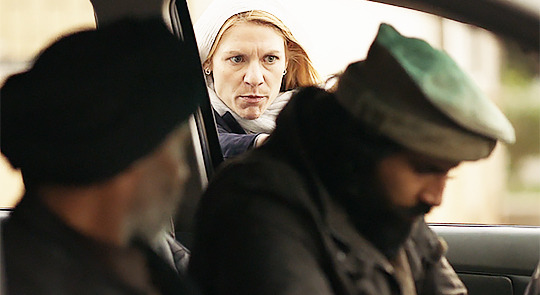
We’re still divided on the merits of the “Carrie has to save Samira” storyline, but the camerawork here, with Carrie’s armed hands appearing out of nowhere, was pretty cool.
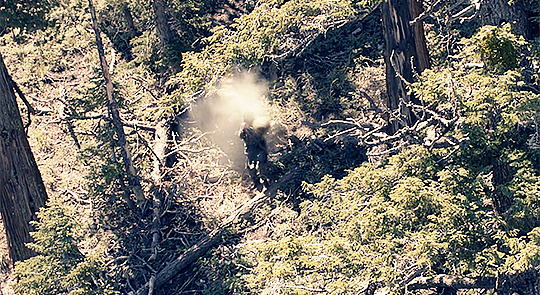
This RPG shot was one of the cooler special effects the show has done in a while. The entire sequence of Chalk One looking for Chalk Two was tense and thrilling and extremely well-executed.

Bringing us back to the ops room, the “LOSS OF SIGNAL” projected now for both helicopters is pretty chilling.
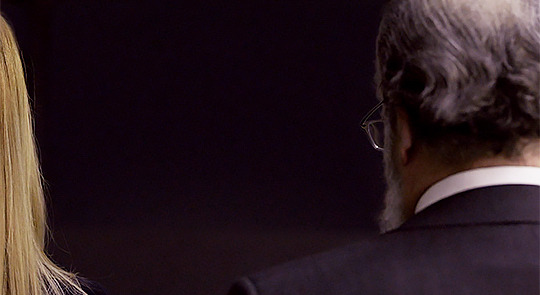
This is now Sara’s favorite shot of the entire series and we’d be remiss if we didn’t mention that it’s another over-the-shoulder Saul shot. This time he observes one of the crowning achievements of his long career literally blowing up in his face.
Visually, this shot anchors the viewer back to the Carrie/Saul relationship, the central one of the show. The black blankness--and the failure it represents--engulfs the frame.
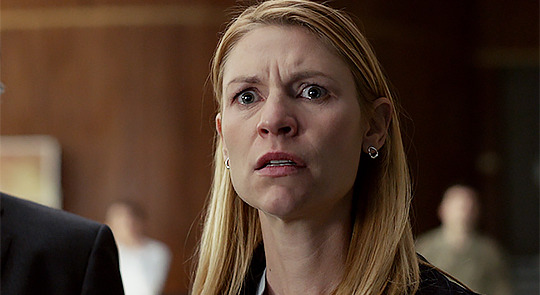
We love the choice to end the episode on Carrie alone. It refocuses the event back to her. The horror in her eyes, welling up with tears, is palpable. How does Carrie feel? Alex Gansa explained that the writers wanted to create a new 9/11 with this maybe-assassination of the president. And it’s a fitting bookend for the show in many ways. In Homeland’s pilot, Carrie says she “missed something that day,” misdirecting blame to herself for not preventing 9/11. Now, in the final season, the show seems poised to tell a story in which Carrie is blamed for the “new 9/11.”
Strap in, folks. It’s gonna be a rough ride.
2 notes
·
View notes
Text
4. When Civil Liberties Clash
(LGBTQI + Religious Harm = Something’s Gotta Give)
Civil liberties often clash. When this happens, as the idiom says, something’s gotta give. We’ve all heard of limitations on free speech when individuals are defamed in public. You can’t exercise free speech if you’re badmouthing someone and it’s not in society’s interest to do so. People in free societies also generally frown on cruel and outmoded practices like stoning of adulterers, even though the Abrahamic religions contain instructions to do so – and it does happen in some societies.
My point is: it’s never a question of whether freedom of speech or freedom of religion can / should sometimes be limited. Both of them can, and should, sometimes. It is only a question of when.
(Quick disclaimer: my point of departure has always been, and continues to be, that the State should only get involved in these clashes when absolutely necessary, so civil liberties should be maintained as the default position, and limited only by exception and as little as possible – for reasons of combating serious and demonstrable harm.)
Given the examples above, it’s clear that the clash between LGBTQI rights and Religious Freedom doesn’t alone as a clash between competing civil liberties. A foundational premise of this dissertation is that absolute tolerance ultimately leads to an intolerant society. That’s because tolerating all intolerance means the intolerant have free rein and ultimately simply take over. For those with a more philosophical bent, Popper’s Paradox of Tolerance is the relevant reference for further reading.
Tolerance is generally understood to be the ability or willingness to leave, unmolested, opinions or behaviour that one does not necessarily agree with[1], and intolerance is an inability or unwillingness in this regard. (It’s important to note that respect is not a necessary condition for tolerance. In fact, tolerance, by definition, is the allowance of ideas or actions that one potentially does not respect, or agree with, to continue unmolested. Respect is more active approval towards ideas and actions than is required by simple tolerance.)
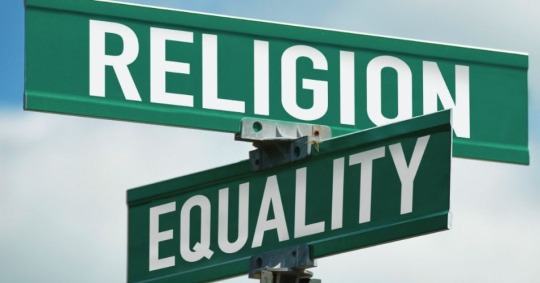
To maintain a functional society, it’s generally necessary to be able to tolerate ideas and actions you don’t agree with, but which do not require legal punishment or (perhaps) even public disapproval. Opposing ideas, by the very nature of human beings, have to coexist in peace for society to continue.
So, what do we do when the rights of marginalised LGBTQI+ South Africans clash with the speech / religious convictions of the religious? How do we maintain a society that retains fair and balanced civil liberties for all, while preventing the religiously intolerant from unfairly imposing prejudice on the LGBTQI+ community (which includes religious people, as pointed out in my last blog)? In order to do so, a certain amount of homophobic thought must be tolerated (it becomes untenable to police people’s thoughts) but, simultaneously, where thoughts spill over into speech and actions, as also described in my last blog, it needs to be addressed, and potentially curbed – either socially or legally.
Religious homophobia sometimes evokes simple disapproval in social settings, or on social media. Before going to legal prosecution or censorship, social disapproval might be escalated to group disassociation like de-platforming of voices by venues or institutions, or the loss of job. In the context of current societal battles in the areas of social justice for LGBTQI+ and religious intolerance, the question of how much intolerance to tolerate becomes a deeply practical, and deadly serious, one.
It is at this point that the homophobe will tend to cite freedom of speech or religion in defending their actions. To borrow from the world of employment, this is where the well-established concept of fair discrimination[2] becomes relevant.
Yes. It is possible to respond heavy-handedly. It is nevertheless crucial to understand that fair curbing of freedom of speech or religion in order to prevent demonstrable harm to marginalised groups should not, itself, be illegitimately construed as more oppression. A response to homophobia that is proportional to the severity of the religious homophobia being countered falls into the realms of self-defense, and is in no way the moral equivalent of someone preaching hate and trying to hide behind a false biblical pretext.
The fact that a state, especially a secular state, includes a large majority of adherents of a particular faith, does not (in my view) translate into an obligation for that state to make special accommodations for religion – and especially not at the cost of marginalised people. There seems to be little reason to think that, just because a religious group happens to be in the majority, appropriate response in the form of SI should be limited to a greater extent than would be the case in a state without such a majority. If you’re interested in deeper reading on the discussion about when to afford protection to religious speech that might contain harmful homophobia, check out Brian Leiter and Martha Nussbaum’s Why Tolerate Religion[3] and Nussbaum’s The New Religious Intolerance[4], respectively.
In short, I don’t believe it’s justified (either socially or legally) to give biblically based homophobia special accommodation (legal exemption from rules normally applied to all citizens, or special permission to express religious or conscience-based convictions in ways that contradict laws normally applicable to all citizens).
The implications for society would simply be too grave, in my view. The kind of society that doesn’t care whether marginalised groups are harmed, and gives religious people (of any sort) special latitude to cause that harm, is not the sort of place I’d want to live. Ironically, I don’t think it’s the sort of place religious people would want to live, either, if the tables were turned. A Christian woman denied a passport without her husband’s permission (as happens in some Islamic states) would become the subject (rightly) of massive outrage here in South Africa. So why are we allowing harm to come to our LGBTQI+ compatriots on the basis of Christianity itself?
Neutrality on the part of the state is everyone’s best protection against the tyranny of some other majority. Basic accommodation by the state of all our civil liberties should be enough for everyone. Write to me if you have thoughts or questions!
[1] Cambridge Dictionary, Definition of 'tolerance', https://dictionary.cambridge.org/dictionary/english/tolerance,
Collins English Dictionary, Definition of 'tolerance, 'https://www.collinsdictionary.com/dictionary/english/tolerance,
Oxford English Dictionary, Definition of 'tolerance,
https://en.oxforddictionaries.com/definition/tolerance
[2] South African Parliament, Employment Equity Act, No 55 of 1998, Ch. 2, section 6
[3] Brian Leiter, 2013, Why Tolerate Religion?, Princeton University Press
[4] Martha C. Nussbaum, 2012, The New Religious Intolerance, The Belknap Press of Harvard University Press
1 note
·
View note
Text
UC 48.31 - Bristol vs St Edmund Hall, Oxford

Bristol and Teddy Hall faced off last week as the only unbeaten teams left in the quarter finals, with Durham having already completed their smooth progress to the semis with their win over Edinburgh. Oxford captain Freddy Leo had been his side’s star player up until this point, with twenty eight (28!) starters in his three appearances. He would need to keep up his good form against a Bristol quartet who spread their buzzing throughout the team.
Anyway, let’s not bother with the rules, here’s your first starter for ten...
Iredale was the first to buzz, for Bristol, and they took a hat-trick of questions on the poet Elizabeth Bishop. Flouting my assertion that it was Teddy Hall who were the one-man team, Iredale kept up the good work with the next three starters. Leo, who had come storming out of the blocks in all of his previous matches, could do nothing but sit still and applaud the Avonside side as they beat him to the buzzer again and again. It was four for Iredale, then Sumner and Le Maistre joined the party. One hundred points to minus five. It could have been a hundred and five too, but for Le Maistre mishearing ‘the fine structure constant’ as ‘define structure constant’, which was, perhaps harshly, disallowed. Sumner, who had given the correct answer, offered his captain the reassuring words, ‘Don’t worry about it’, to which she replied, ‘I’m not’.

Surely it wouldn’t matter though, they were a century clear, and a Teddy Hall side with a misfiring Leo, who had looked imperious in earlier matches, looked completely out of sorts. They couldn’t even pick up the baton when Basu dropped it with a neg, Bresson coming in with Spring rather than Autumn. Leo had clearly known the correct answer, but he was tentative where he once would have been bold, and was waiting until the end of the question. Like Sumner, he assured her it was alright, but from where they were in the contest, he couldn’t have been so sure.
Having been so close to finally getting some points on the board, and perhaps with the realisation that it was now or never to stage any sort of comeback, Leo is not so ponderous on the buzzer for the following starter, this time beating Bresson to Brindisi, bringing his straggling quartet back above zero. I don’t want to say that Leo buzzes are like buses, because usually they’re far more regular, but on this occasion the old cliche held, and he bagged another in quick succession. Actually, maybe it doesn’t hold, because the second was quickly followed by a third, and a fourth, and fifth, which would mean that something had gone horribly wrong with the bus schedules. Iredale got in to complete his own quintet and stop the rot, but only briefly. Teddy Hall had left it late but were now on the charge.
The second picture round also went to Leo, though he was told off by Paxman for a considerable pause between buzz and answer. They took two bonuses, with the second of these seemingly coming to Leo out of absolutely nowhere, following a team conference in which the answer, Martha Nussbaum, had only been mentioned, by Bresson, as ‘That woman who really likes Aristotle’.
With the scores now at 115-100 in Bristol’s favour, Le Maistre buzzed in incorrectly with four (the question doesn’t really matter here) before Leo swooped in to take the points with five, but only after a quite significant calculation stage, involving much head-bobbing and hand-waving. Paxman, having warned him about this only moments ago, and had been in the process of saying ‘you really must answer straight away’, allowed the answer to stand, though somewhat begrudgingly.
A quicker answer from Leo on the next starter, followed by a clutch hat-trick on the bonuses, put Teddy Hall a Full Set clear going into the final few moments. Iredale got his sixth of the evening, but they couldn’t draw level, only taking the one bonus. The next starter would have tied the game for Bristol, but with his sword now well and truly sharpened, it was Leo who predictably came in to seal the game for Oxford, just as the gong crashed.
Final Score: Bristol 130 - 150 Teddy Hall
Had Leo not been given the points for the questions where he hesitated (especially the second time, having already been given a warning) then Bristol may have won. And on another day that may well have happened. Naturally, this irked a number of people on the good old Internet, who believed, possibly even correctly, that this was unfair, and that Leo was somehow cheating. This is misplaced irk - its not his fault that the rules are not as clear as they could be.
This weekend Sergio Aguero scored twice for Manchester City as they came back from 2-0 down against Swansea in the FA Cup (in some ways a similar tale to this: both were quarter finals featuring an Welsh underdog taking on an established power, in this case Oxford). The first of these goals was from a wrongly awarded penalty and the second was offside. However, neither of those facts was Aguero’s fault, and he scored those dubious goals in the same way that Leo scored his hesitant points.
Its not clear how long you’re supposed to get to answer after you buzz on University Challenge. Sometimes, if the question involves maths, Paxman will say that contestants must answer immediately, but other than that its entirely down to his discretion, which is why it can seem inconsistent. The exact same issue exists on the bonus questions where teams can take as long as a minute discussing and debating a single five point question. Again, this happens because there’s no hard (or even soft) time limit, and it can be very annoying for the trailing team when the leading team takes an age conferring every time they get a starter right.
This is also an issue in the first round when it comes to the highest scoring losers, as some teams will have had the chance to answer more questions than others. Of course, that issue could only be made one hundred percent fair by having all of the matches take place with the exact same questions, which would make for pretty boring TV. But there are some things that the Challenge could learn from Quizbowl that would clear up a few of these grey areas and minimise the potential for accusations of favoritism and general unfairness.
Firstly, the first round could be operated on the basis of a set number of questions rather than a time limit. This would mean that each team has the same chance to amass the highest losing score (even without the implementation of identical question sets). In the later rounds, where the actual points scores are no longer important, you would simply need a clearly defined ‘thinking time’ between buzz and answer, and something similar for the conferring time on bonuses. I can’t see any downsides to this, as it does nothing but speed up the game, making it more exciting from the get-go.
Remaining Quarter Final Matches:
Darwin, Cam vs Emmanuel, Cam
Edinburgh vs Bristol
Manchester vs Darwin/Emmanuel
If you were so astounded by this review that you fancy buying me a coffee, you can do so here, thanks. http://ko-fi.com/universitychallengereview
1 note
·
View note
Text
The Fascist Hindutva
Dismantling Global Hindutva (DGH) Conference: A Game-Changer
— 12th September 2021 | Dr. Farah Naz | STRAFASIA

The Fascist and the Ugliest Face of Hindutva
The unprecedented conference ‘Dismantling Global Hindutva’ held from 10-12 September 2021 is a game-changer. The purpose of the conference was to bring together leading scholars in South Asian Studies and public commentators on Indian society and politics around the world to discuss the global phenomenon of Hindutva. It aimed to protect the rights of minorities, dissidents, and ordinary people whose very existence is under attack by Hindutva’s proponents. The conference promoted the ideology that universities are designed to foster and protect the principle of academic freedom. The massive campaign of intimidation carried out by Hindutva affiliates was not allowed by the conference organizers to take root in the academia in the US, Europe, or around the world.
The conference was backed by 45 plus departments and centers from 41 universities including Stanford, Harvard, Princeton, University of Chicago, Berkeley, North-Western, etc. They had more than 70 co-sponsoring entities from 53 universities and received a letter of support from over 900 academics across the world. Most of the panelists were Indian academics serving in the elite universities and think tanks in the western world. The organizers received life threats to themselves and their families therefore they decided to remain anonymous. The harassment and intimidation against speakers by the Rashtriya Swayamsevak Sangh (RSS) were reported by all top-notch newspapers. The presenters shared how they received life threats, suspension of their passports and other serious threats to their families by the Bharatiya Janata Party (BJP) and RSS supports across the globe to suppress their voice and stay away from the conference. While listening to the speakers’ experiences of revealing threats it was shocking and surprising that India that claims to be a democratic country does not care about academic freedom and basic fundamental rights for its citizens.
Despite a massive campaign of disinformation, threats, torture and attacks the conference was held online. According to the organizers, when the attack began, the conference media department prepared to counter the Hindutva attack. Hence, Vinay Lal (UCLA), Martha Nussbaum (Uni of Chicago) and David Ludden (NYU) came to the front and extended support to address the media concerns regarding the event.
The question is what is Hindutva and where it emerged from? The term Hindutva came in the 19th century. Its narrative is deeply rooted in Brahmanism and is the offspring of Hindusim. Its strategy is based on violence, hatred, terrorism and is an enemy to democracy. Existing Hindutva is resistant to castism. The supporters of Hindutva ideology use different means to achieve the objectives.
Hindutva has emerged from the RSS that is an Indian right-wing Hindu nationalist, paramilitary volunteer organization founded in 1925 by K.B Hedgewar. In 2020, RSS had almost 585,000 members and over 57,000 branches, including a trade union wing (Bharatiya Mazdoor Sangh), women’s wing (Rashtriya Sevika Samiti), student wing (Akhil Bharatiya Vidyarthi Parishad), and economic wing (Swadeshi Jagaran Manch). The Print, which is a well reputed Indian news outlet estimates that 3 out of the 4 ministers in the ruling BJP are members of the RSS, including the current Prime Minister, Narendra Modi.
Here the issue is why is India under Modi scared from such an academic venture like DGH? Also, what were the biggest fears of BJP and RSS from the DGH conference? The conference was comprised of scholars, journalists, and activists from around the world who examined the historical development of Hindutva, the fascist dimensions of its ideology, its alignment with other supremacist movements and defined all that is at stake across a range of political, socio-cultural, and economic issues. The presenters unveiled the atrocities and pain caused by RSS both within and outside India.
At the DGH conference, the speaker Gyan Prakash, Christophe Jaffrelot, Meena Kandasamy, Anand Patwardhan talked about what is global Hindutva and how it poses threats to minorities, women and Muslims. The political economy of Hindutva was uncovered by Jens Lerche, Pritam Singh and Vamsi Vakulbharnaman. How Hindutva exploits castism was discussed by Gajendran Ayyathurani, Meena Dhanda and Bhanwar Megawanshi. The way Hindutva use rape as a weapon to exploit politics was examined by Leena Manimekalai, Akansha and P. Sivakami. The contours of the nation were explored by Mohammad Junaid, Arkotong Longkumer, Yasmin Saika and Nandini Sundar. How Hindutva under Modi mishandled the COVID-19 pandemic and posed a serious threat to Indian people, science and healthcare were discussed by Meera Nanda, Kavita Sivaramakrishnan and Banu Subramanian. The infamous Hindutva fake news propaganda campaign was unveiled by Cyril Sam and Salil Tripathi. The difference between Hindusim and violent Hindutva were explored by Raja Bhattar, Brij Maharaj and Sunita Vishwanath. Last but not the least Islamophobia, White supremacy and Hindutva were brought to light by Anjali Arondekar, Demetrius Eudell and Deepa Kumari. The members from the Feminist Critical Studies Collective had a good representation at the conference.
It is worth mentioning that all speakers came from the top twenty most elite universities in the world. They were on high profile designations and well known in their respective field of expertise. From Hindutva extremist ideology to ill-treatment of the women, transgender issues, minority exploitation, extreme policies towards Muslims both within and outside India, violation of the rights of Kashmiris and overall violation of the basic fundamental rights of Indian academics, medical practitioners and so on. The list is quite huge to be shared here.
In a nutshell, the conference highlighted that RSS under Modi is the largest organized extremist hate group in the world. It draws its inspiration from Nazi ideology and Italian fascism. Its guiding principle is to transform India from a secular democracy to a religious state where Muslims, Christians and other religious minorities are relegated to a second-class citizenship. In the name of Hindutva, the current government of India has instituted discriminatory policies including beef bans, restrictions on religious conversion and interfaith weddings and the introduction of religious discrimination into India’s citizenship laws. These measures led to a horrifying rise in religious and caste-based violence, including hate crimes, lynching and rapes directed against Muslims, non-confirming Dalits, Sikhs, Christians, Adivasis and other dissident Hindus. Women of these communities are specially targeted. Modi government has used every tool of harassment and intimidation to muzzle dissent. Dozens of student activists and human rights defenders are currently languishing in jail indefinitely without due process under the repressive anti-terrorism law.
In response to DGH, the RSS launched ‘Dismantling Global Islamic Jihad’ on 11 September 2021. That shows the RSS cunningness, intolerance and hatred towards Muslims, minorities, human rights, freedom of speech and freedom of academics. The DGH conference has rightly concluded that India has moved away from a secular state that it inherited to a purely Hindutva state where only Hindutva decides whom India will love or hate! Hence Indian democracy is designed to serve only Hindutva, not the common Indian citizens!
— Dr Farah Naz is a Professor at S3H National University of Science and Technology (NUST), Islamabad
0 notes
Text
Loops, the Limits of Language, the Paradoxical Loneliness of “I Love You,” and What Keeps Love Alive
The very task of love and of language is to give to one and the same phrase inflections which will be forever new.
When I walk — which I do every day, as basic sanity-maintenance, whether in the forest or the cemetery or the city street — I walk the same routes, walk along loops, loops I often retrace multiple times in a single walk. This puzzles people. Some simply don’t get the appeal of such recursiveness. Others judge it as dull. But I walk to think more clearly, which means to traverse the world with ever-broadening scope of attention to reality, ever-widening circles of curiosity, ever-deepening interest in the ceaselessly flickering constellation of details within and without. In this respect, walking is a lot like love — for one human being to love another is to continually discover new layers of oneself while continuously discovering new layers of the other, and in them new footholds of love.
This renders the exchange of I love you’s — that coveted contract of mutuality — a strange sort of transaction, currency encrypted with change, with the loneliness and loveliness of change: In any love worthy of the name, the I and the you are ever-changing, so that the love binding the two is ever-renewing. But perhaps the strangest and most lonely-making aspect of I love you is that it traps the boundlessness of love in the limits language, as narrow and straining a conduit of love as the crack in the wall between Pyramus and Thisbe.
Thinking about this on one of my cemetery loops, because the act of walking is also a mighty machete for clearing the pathways of memory overgrown with life, I suddenly remembered a passage by the French semiotician and philosopher Roland Barthes (November 12, 1915–March 26, 1980) from his superb 1977 part-autobiography, part-rebellion against the conventions of life and of the telling of life-stories, Roland Barthes by Roland Barthes (public library) — the playful, profound, blazingly original self-interrogation that gave us his existential catalogue of likes and dislikes.
A hundred pages into the book’s larger meditation on the limits of language — our primary tool for narrating our inner lives so that we can understand ourselves and be understood — Barthes writes:
“Does not this whole paroxysm of love’s declaration conceal some lack? We would not need to speak this word, if it were not to obscure, as the squid does with his ink, the failure of desire under the excess of affirmation.”
With an eye to the limitation of these words — of all words — as “the primary and somehow insignificant expression of a fulfillment,” Barthes adds with a conspiratorial wink:
“There’s no help for it: I love you is a demand: hence it can only embarrass anyone who receives it, except the Mother — and except God!
Unless I should be justified in flinging out the phrase in the (improbable but ever hoped-for case when two I love you‘s, emitted in a single flash, would form a pure coincidence, annihilating by this simultaneity the blackmail effects of one subject over the other: the demand would proceed to levitate.
All (romantic) poetry and music is in this demand: I love you, je t’aime, ich liebe dich! But if by some miracle the jubilatory answer should be given, what might it be? What is the taste of fulfilment?”
But then Barthes considers “a delicate way out of the maze.” In an allusion to the Ship of Theseus — the brilliant ancient Greek thought experiment exploring what makes you you — he intimates that the only thing which makes love love is its self-renewal in the consciousness of the lover despite the self-exhausting loops of its declaration:
“I decide that [the declaration of love], though I repeat and rehearse it day by day through the course of time, will somehow recover, each time I utter it, a new state. Like the Argonaut renewing his ship during his voyage without changing its name, the subject in love will perform a long task through the course of one and the same exclamation, gradually dialecticising the original demand though without ever dimming the incandescence of its initial address, considering that the very task of love and of language is to give to one and the same phrase inflections which will be forever new.”
Complement with Robert Browning — one of those rare romantic poets who rose above Barthes’s indictment — on saying I love you only when you mean it and Rainer Maria Rilke — one of those rare post-romantic poets who refused to treat romance as a transaction of conveniences — on what it really means to mean it, then revisit philosopher Martha Nussbaum’s Proust-fomented litmus test for how you really know you love somebody and Adrienne Rich on earning the right to use the word love.
Source: Maria Popova, brainpickings.org (18th January 2021)
#quote#love#life#language#meaning#all eternal things#love in a time of...#intelligence quotients#depth perception#more than words#underneath it all#from the heart#stands on its own#elisa english#elisaenglish
0 notes